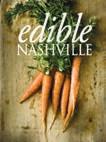Celebrating local food culture in San Diego County No. 49 • September–October 2018


Celebrating local food culture in San Diego County No. 49 • September–October 2018


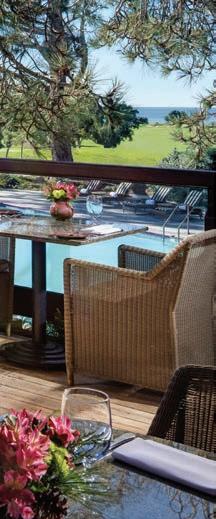

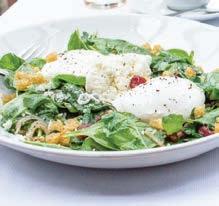
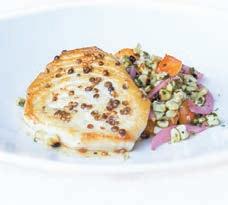
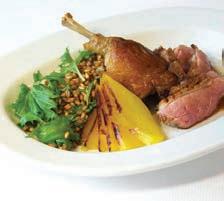

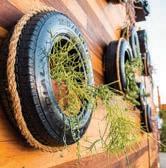
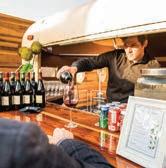



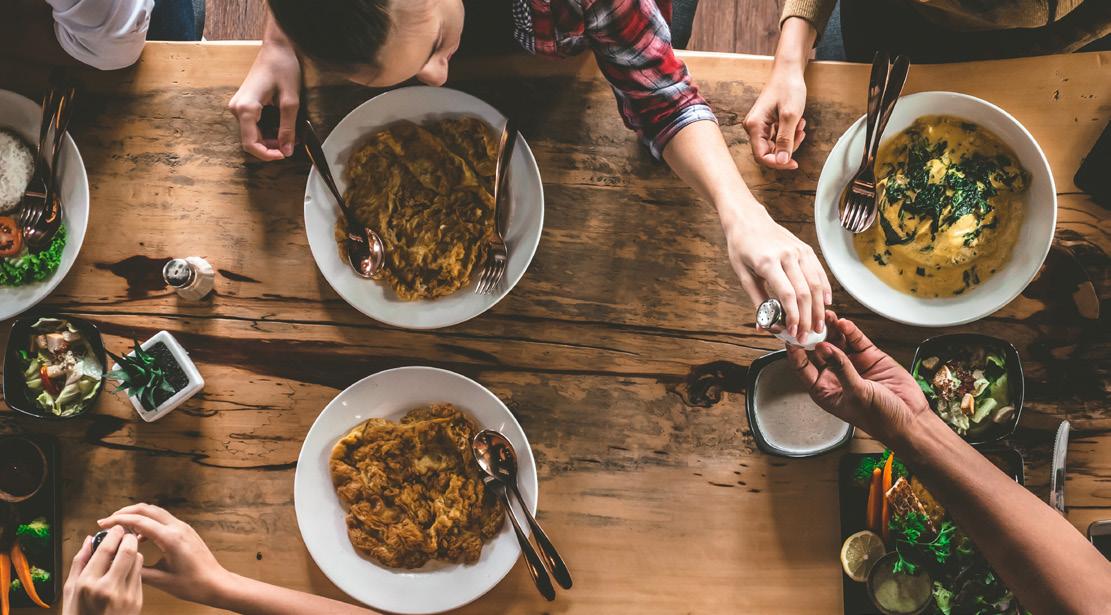



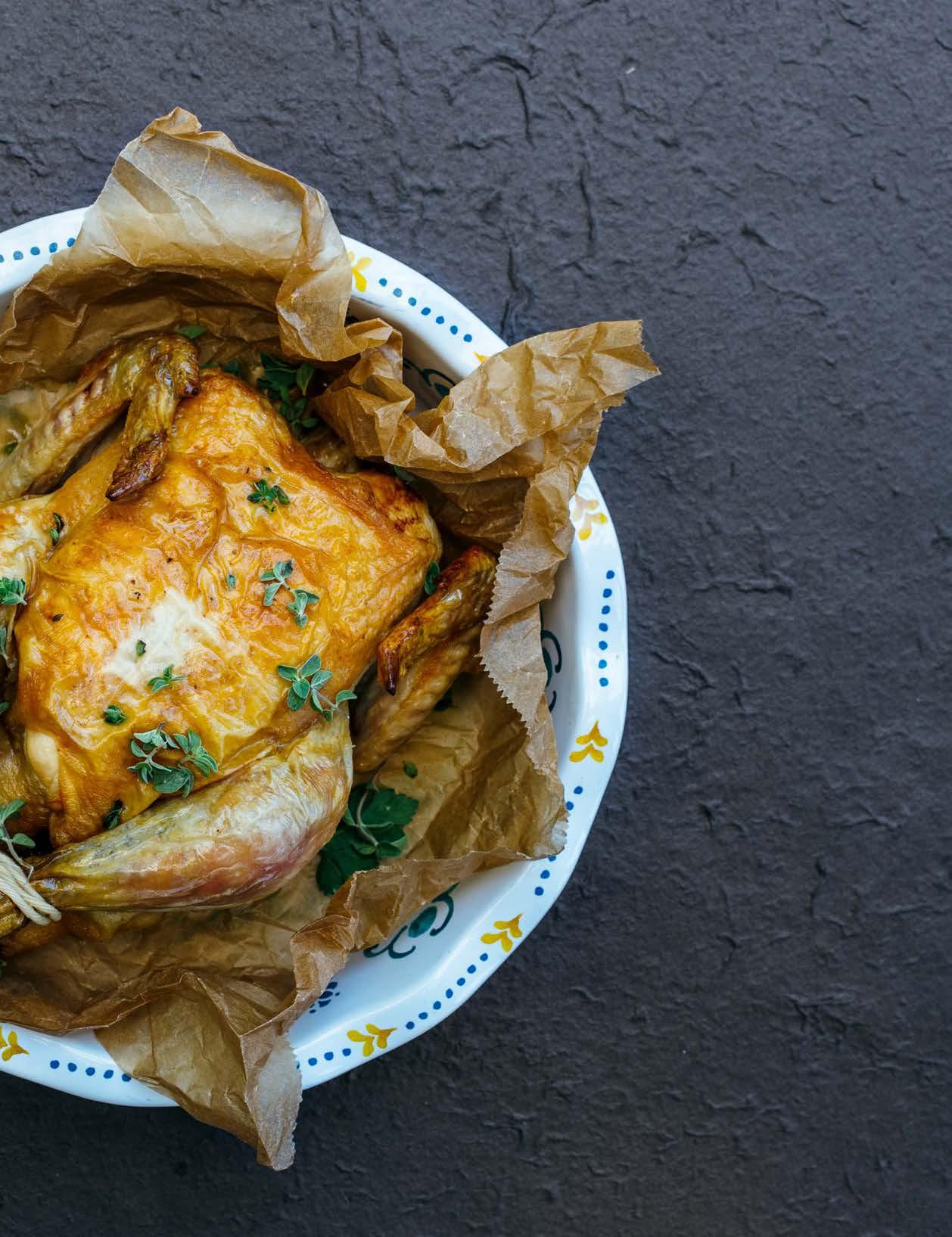
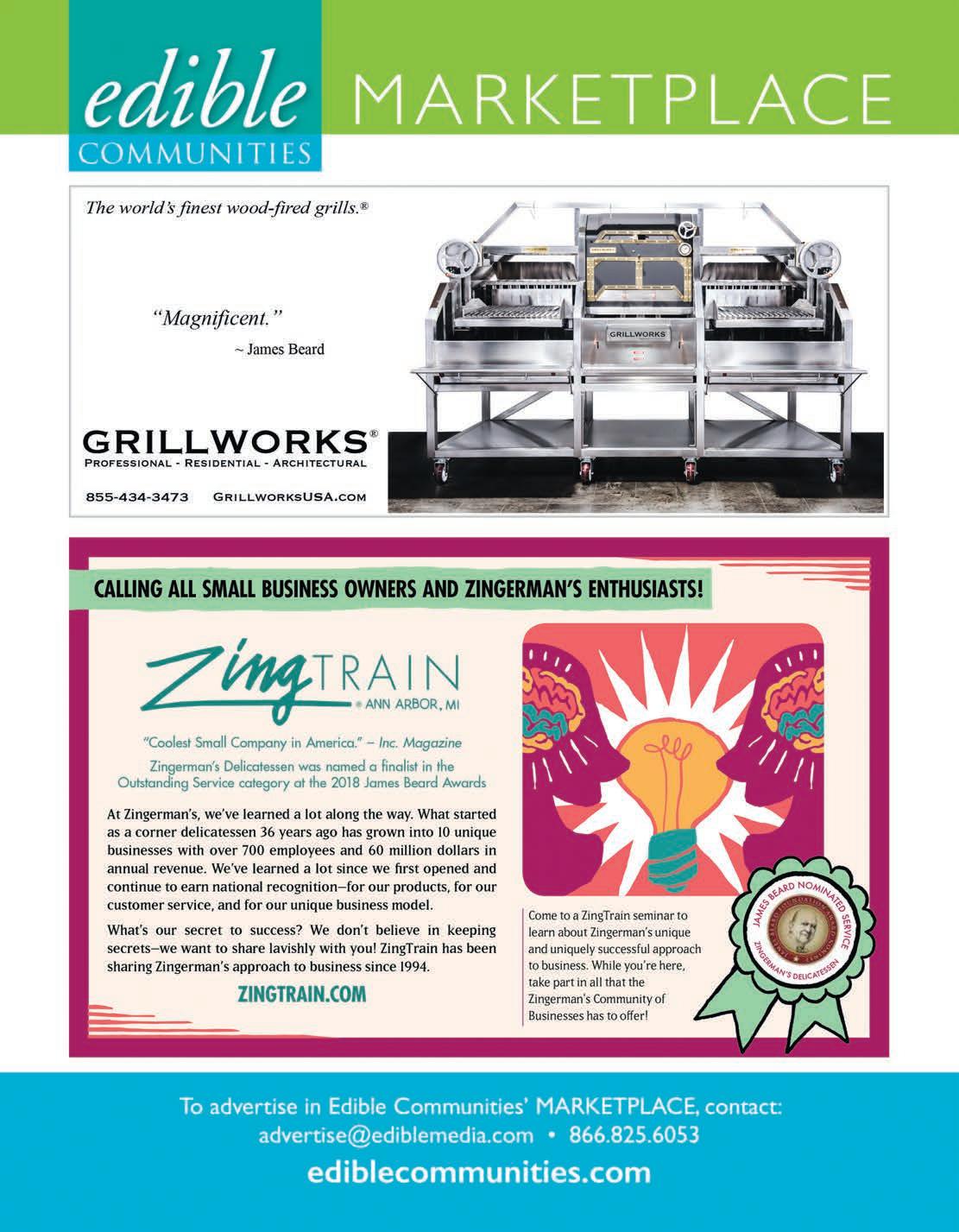
At this precise moment in time, each of us is on our own health journey. How is yours going?
If I look back on my early days to where I am right now, and where I am headed, I must say I have learned a lot and want to keep learning. How about you?
Are you getting the feeling that this is a dialogue? It is. In fact, it’s a conversation about wellness that defines our purpose here at Edible San Diego
We want to welcome you to this special edition, a bold and exciting experiment in which we present information about one of the most topof-mind questions about health these days: How do you get your protein?
Of course proteins are only part of eating healthy. We selected the topic and the unique structure of this issue to do two things: to provide you with current, relevant information as you make eating choices every day, and to connect you with options that are specific to San Diego County. Yes, local is our signature, our mission, and our eternal focus. Why? Because the stakes are immediate and high, for each of us individually and for our regional food system.
For the third time during our 10th anniversary year, we partnered with a guest editor to bring in some expertise and new connections that add value to the conversation and the journey. This time, instead of an individual, we teamed up with Bastyr University, which offers an integrated approach to education, research, and clinical service here in San Diego and in Kenmore, Washington.
In today’s high-speed and digitized world, people often tell us how much they love our magazine—and how long they keep it! With this Protein Power issue, we offer reference material with extra impact and longevity. As you may or may not know, Edible San Diego posts a digital version of this magazine on our website, which features new stories every day; we also share content monthly in our gorgeous e-newsletter and are busier than ever on social media. Tell your friends!
Here at Edible San Diego, we take your wellness journey seriously. We’re evolving fast and want to walk hand in hand with you and whatever health challenges you’re facing or taking on. There will be bumps, some hills, reasons to celebrate, and unexpecteds, but we’re on this journey of wellness in our regional food system together with you, here and now. We got this.
edible Communities

2011 James Beard Foundation Publication of the Year

The nutrition faculty at Bastyr University is on a mission to support the local community through health and nutrition education. Bastyr University opened its campus in San Diego in 2012, while the main campus in Washington state recently celebrated its 40th anniversary. Bastyr is a global leader in evidence-based natural health education, and the local campus located in Sorrento Valley offers two nutrition degrees: Bachelor of Science in Nutrition and Culinary Arts (BSNCA) and Master of Science in Nutrition for Wellness (MSNW).
information and present it in a way that motivates and empowers. This innovative approach propels graduates to become transformative agents of change in our local community and in the world at large.
CONTRIBUTORS
Jackie Bryant
Joni Hargrave
Olivia Hayo
Maria Hesse
Annelise Jolley
Stephanie Parker Nan Sterman Katie Stokes
PUBLISHER
Katie Stokes
EDITORS
Katie Stokes Executive Editor
Maria Hesse Managing Editor
Felicia Campbell Executive Digital Editor
Dawn Mobley
Copy Editor
Fernanda Larson and Dr. Neal Malik
Bastyr University
Guest Editor
DESIGNER

Riley Davenport
BUSINESS DEVELOPMENT
EXECUTIVE
Scott White
MARKETING
Cass Husted
SALES REPS
Debbie Cole
Tanaira Cruz
John Vawter
Joyce Wells CONTACT
Edible San Diego P.O. Box 83549 San Diego, CA 92138 619-756-7292 info@ediblesandiego.com ediblesandiego.com



ADVERTISING
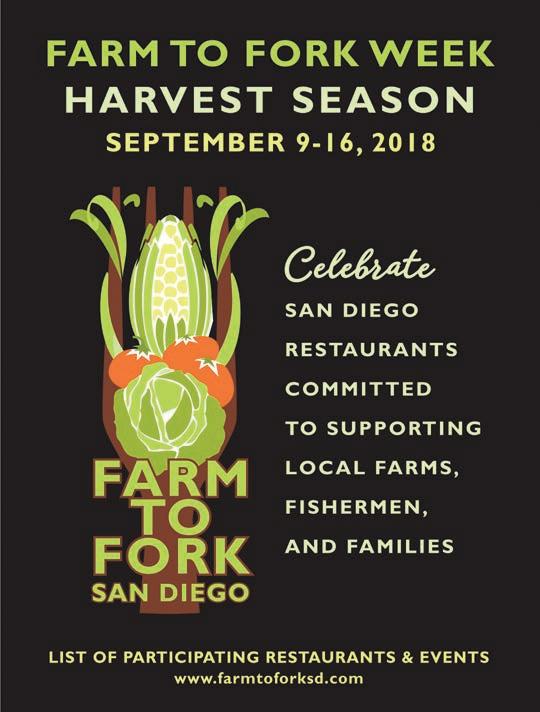
For information about rates and deadlines, contact info@ediblesandiego.com 619-756-7292
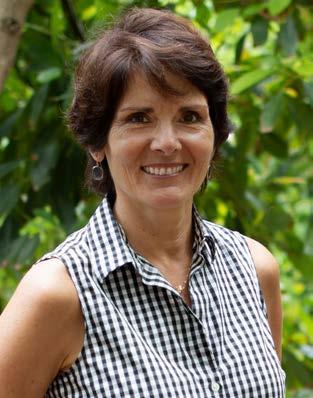

No part of this publication may be used without written permission of the publisher. © 2018 All rights reserved. Every effort is made to avoid errors, misspellings, and omissions. If an error comes to your attention, please let us know and accept our sincere apologies. Thank you.
Bastyr’s nutrition faculty, with diverse backgrounds that complement the needs of the program and students, inspire students to create and maintain wellness by combining a rigorous science background with culinary nutrition, exercise physiology, and community health. Bastyr’s unique nutrition programs transform students into “nutrition translators” by enabling them to take complex and often conflicting
Fernanda Larson is a Bastyr alumna and assistant professor specializing in culinary nutrition with an emphasis on whole-foods philosophy, therapeutic cooking, and recipe adaptations. She has been teaching healthy cooking for over 15 years.
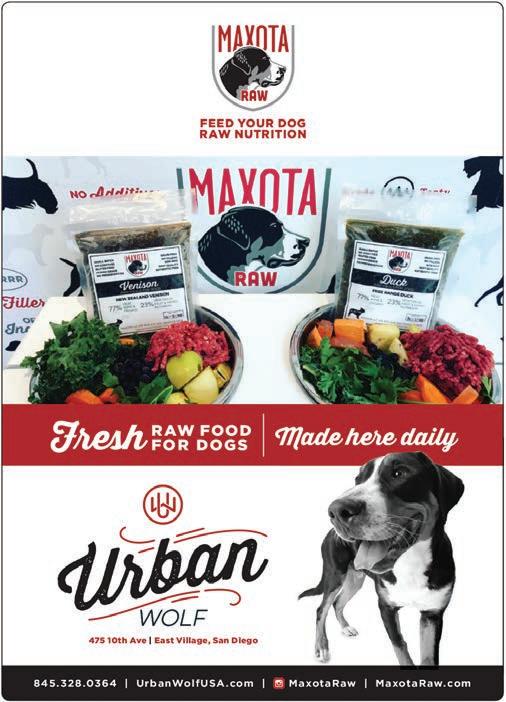
Dr. Shanshan Chen has expertise in developing and implementing health promotion programs and engaging community partnerships. She teaches community-based nutrition courses to MSNW students.
Dr. Neal Malik is an assistant professor and chair of the Department of Nutrition and
Basic Sciences. A published, peer-reviewed scientific literature author and respected media expert in nutrition and wellness, he has written for a variety of publications including Men’s Fitness and eHow.com.
The recipes provided in this issue were created as part of a collaborative effort with the Bastyr nutrition faculty and students to highlight the best possible sources of protein that promote personal, local, and global wellness. D
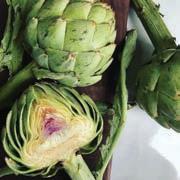
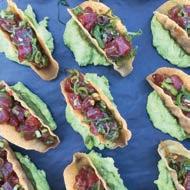
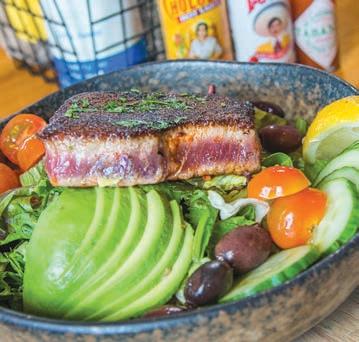
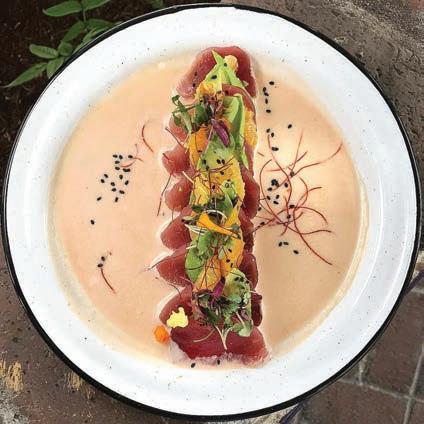 By Stephanie Parker
By Stephanie Parker
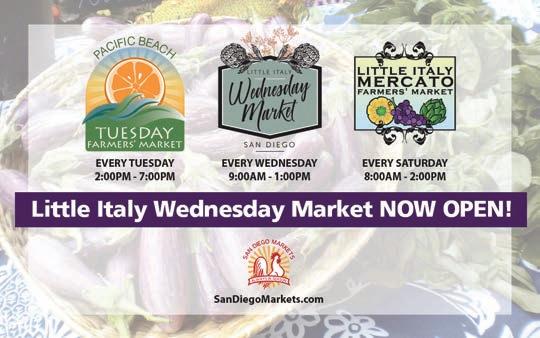
The Dish: Vegan Cheese Board
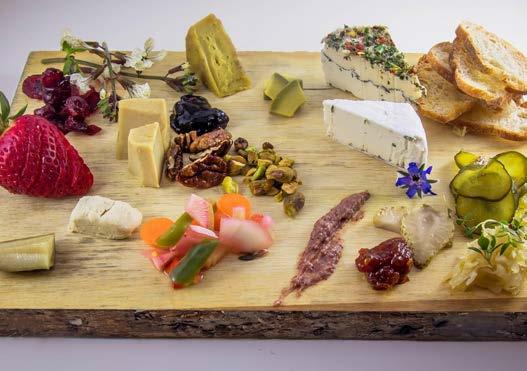
Chef: Darrell Campbell
Restaurant: Masters Kitchen & Cocktail
Details: Housemade nondairy cheeses, locally sourced condiments, Prager Brothers baguette crostini
Why It’s Good: Where else can you get a vegan cheese board that actually tastes really good? Vegans and non-vegans alike have fallen in love with chef Darrell Campbell’s vegan cheese board at Masters. In addition to housemade nut cheeses, the board’s accompaniments include an array of jams, mostardas, and pickled veggies, all of which are made from ingredients sourced from local farms. With so many different flavors and textures to experience, finding your favorite flavor combinations is a fun experiment.
The inspiration for this vegan cheese board came to Campbell when his dairy-free sister and family visited last year. He wanted to create something they could all enjoy and that his sister would love to pair with a glass of wine.

Campbell’s most original vegan cheese is a cashew-based version of the acclaimed Humboldt Fog goat cheese. Made at Masters and given the name O’side Fog, the cashew “cheese” is enhanced with vegetable ash that is beautifully laced through the center. It’s been such a great success that it has become a staple of the restaurant, and Campbell has found that he enjoys creating new dairy-free cheeses to keep the vegan cheese boards interesting.
A true farm-to-fork chef, Campbell can often be found wandering through the vegetable rows at Oceanside’s Cyclops Farms. mastersoceanside.com
The Dish: Seasonal Fruit Croissant Bites
Chef/Owner: Joanne Sherif
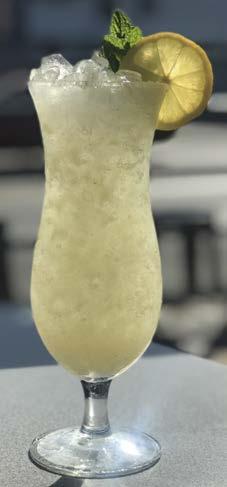
Restaurant: Cardamom Café & Bakery
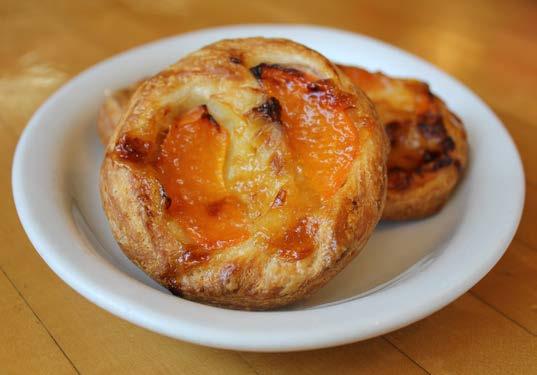
Details: Farmers’ market apricots, Jackie’s Jams apricot jam, brie, puff pastry



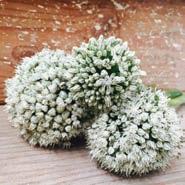

 By Stephanie Parker
By Stephanie Parker

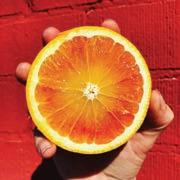
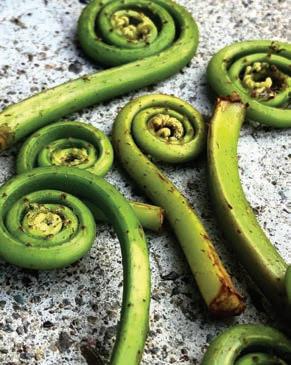
The Drink: Gin Cocktail
Bar: Royale! Details: Old Harbor Distilling Co. 1542 California Native Botanical Gin, lemon, guava syrup, mint
Why It’s Good: Old Harbor Distilling Co. released their 1542 California Native Botanical Gin to celebrate local aromatic ingredients from Nopalito Farm, Royale’s family-owned organic farm in Valley Center. White and Cleveland sage, California sagebrush, elderflower, yucca flower, lemonade berries, and yerba santa were all harvested from Nopalito Farm to complement juniper and manzanita berries foraged from neighboring canyons for this special gin. Fresh lemon juice and a syrup made from four different types of guava are mixed with 1542 gin. Talk about a truly San Diego cocktail—this farm-to-glass libation can only be found at Royale!royalesd.com
Why It’s Good: Cardamom Café & Bakery has been a North Park favorite for 10 years. Owner Joanne Sherif is committed to sourcing the best ingredients, including local produce and seafood, plus grains grown and milled in California. Let’s talk about the croissant bite! Sherif uses this puff pastry to feature seasonal produce she finds at her neighborhood North Park Thursday Market. She loves to play around with sweet and savory combinations that showcase flavors from our region.

The tart I had the pleasure of sampling was made with fresh apricots, Jackie’s apricot jam, and brie. The flavor combinations of fruit and cheese change frequently, ranging from sweet to savory presentations that include everything from roasted beet and goat cheese to turkey with jalapeño cream cheese.

Cardamom Café is also committed to supporting the efforts of the California Grain Campaign, which aims to have farmers’ market bakeries using at least 20% California grains by the year 2020. Sherif incorporates California-grown Sonora wheat into her croissant dough, Bloody Butcher cornmeal in her scones, and rye flour in her cookies.
cardamomsandiego.com
When it's about food... #specialtyproduce
www.mitchsseafood.com

There’s a house on my street whose front yard is a thicket of Opuntia cacti. The upright, round, deep green pads stack up, one above the next, forming an impenetrable living fence.
In late spring or summer, this beautiful stand of cactus (also known as a prickly pear) erupts in bright yellow, orange, or pink flowers. By late summer or fall, the flowers morph into rich, red cactus pears. That’s when cars appear and people wearing thick gloves fill boxes with the spine-covered fruits—with permission from the owners, of course.
Opuntia is a staple of Mexican cuisine, both the sweet, seedy fruits—referred to as tunas in Spanish—and the green pads, or nopales.
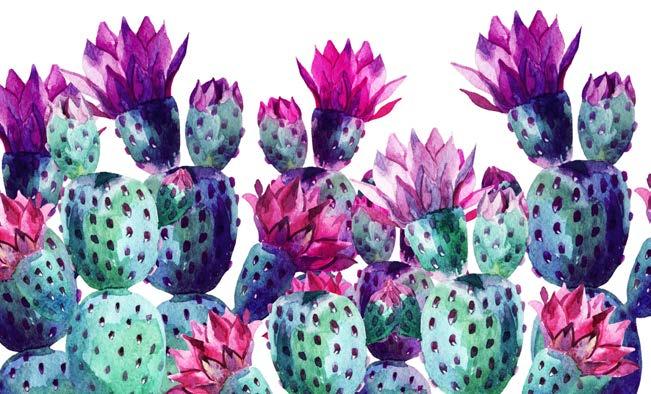
While my neighbor’s tunas ripen deep red, some cactus pears ripen bright gold. Tuna fruit is delicious eaten fresh or made into a syrup to use in sorbet, cocktails, baking, and other sweet treats.
Nopales, the cactus pads, can be harvested any time of year. Recipes often prefer smaller, younger pads for their tender texture. I’ve seen recommendations for harvesting pads in the morning, since cacti have a different way of photosynthesizing, and by afternoon the pads can taste bitter. That bitterness disappears overnight.
Wear gloves to harvest nopales, and begin by cutting the blades at the base. After burning or cutting off the spines, the pad is often grilled or boiled and diced before adding to omelets, casseroles, salsas, and other traditional Mexican dishes.
Growing an Opuntia cactus is simple, especially if you know someone who already has a plant. With a very sharp

knife, cut a pad off at a joint, which is basically located at the base of a pad. Look to make the cut where it connects to the next pad down.
Let the cut end dry for a few days, then place the cut end of the pad a few inches deep in a pot of coarse sand. The pad will root very quickly, in just a few weeks, at which point it will be ready to transplant to the sunniest, hottest area of the garden.
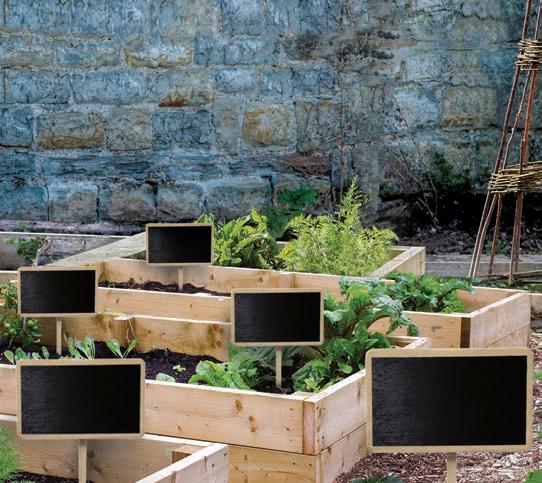
Alternatively, bury the cut end in a few inches of well-draining soil in a sunny, hot spot of the garden. Once you see new pads developing, that’s the sign that you’re about to have your own fresh supply of tuna and nopales.
Opuntia is one tough plant! Once it roots in your garden, it requires almost no care at all. Even in the hottest desert areas, it needs very little water after its first few months in the ground. I set a pad onto a sandy spot in my garden about eight years ago and never watered it. It is now a mass of pads over eight feet wide and six feet tall that blooms from late spring into early summer.
The only significant Opuntia pest is a scale insect commonly called cochineal. These bugs are the source of the valuable red cochineal dye traditionally used to color textiles, foods, cosmetics, and other materials. It’s hard to miss a cochineal scale
infestation; you’ll see white waxy bugs covering the pads. Smash some between your fingers and the rich, red dye will squish onto your skin. A very serious infestation can kill the plant, though I’ve seen massive stands of Opuntia covered in cochineal growing perfectly well. That said, a sharp spray of water will knock the scale off the pads. If that doesn’t work, spray with an insecticidal soap early in the morning or late at night. Be sure to check all surfaces of the plants including the leaf joints. The soap only kills the cochineal it covers, so repeat the treatment until there is no visible evidence of the cochineal.
Be cautioned to always wear thick gloves and use tongs when handling Opuntia pads and fruits. Their surfaces are covered in fine, spiny glochids (sharp bristles) that you do not want to get in your skin. If you are so unfortunate, use duct tape to cover the spines stuck in your skin. When you rip off the tape, the glochids will come with it—but you might need to repeat the process several times.
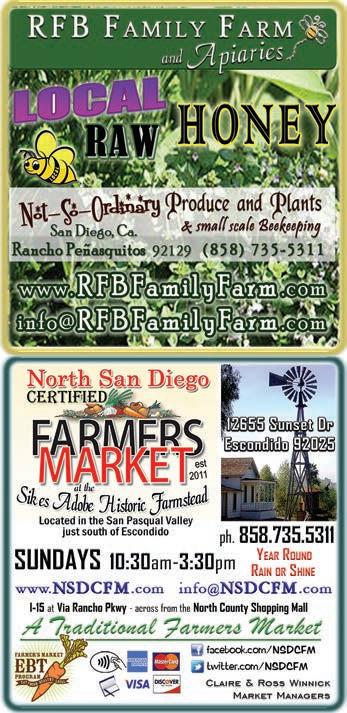
Fun fact: In Hebrew, Opuntia cactus fruits are called sabra, a term that is also a nickname for native Israelis because, like the fruits, they are tough on the outside but sweet on the inside. D
Garden expert, designer, and author Nan Sterman specializes in low water, sustainable, and edible landscapes. She is the host of “A Growing Passion,” a TV show on KPBS that explores how plants power the planet. See past episodes online at AGrowingPassion.com. Sterman’s latest book is the just-released Hot Color, Dry Garden available in bookstores, online, and on her website www. waterwisegardener.com. She runs the popular Facebook group San Diego Gardener and leads international garden tours.
Proteins, those complex chains of amino acids that are a part of every living organism, happen to be a topic at the center of almost every nutritional and dietary recommendation ever made. If you’re someone making informed choices about the things you eat to fuel your body, you’re probably (frequently) thinking: Am I getting enough protein? How much protein should I be eating? What types of proteins are best for me?
At least, we often ask ourselves these same questions here at Edible San Diego. Meanwhile, readers are often asking us another question: What can be done to support a healthier local food system? So we thought we would look for answers to these questions, together.


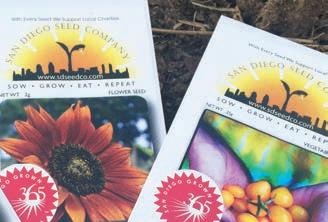
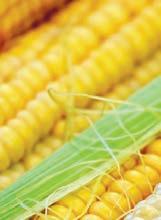


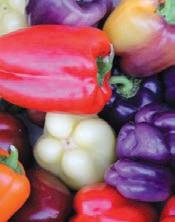


This special feature explores the proteins that power conscious eaters across the region. In our food coverage, we look to be inclusive of all of you living in this massive metaspace of dietary lifestyles in a way that honors each individual’s perspective and choices. Our content is not intended to provide medical or nutritional advice, and we encourage our readers to seek support from specialists as needed. So whether you’re a plant-loving vegan, an MMA-fighting Paleo devotee, or someone looking to make a better choice when seeking a convenient and delicious grass-fed cheeseburger, we’ve got you covered.
It’s part of our mission to get you to think about where your food comes from. We know that something’s not necessarily healthy and sustainable just because it’s local. We know that there are barriers to accessing best choices, most often starting with time and energy at the end of a long day. But, for those who seek wellness for themselves and the planet, we can work to make better choices when and where we can.
Many thanks to our guest editors from Bastyr University for contributing simple, versatile, delicious, and nutritionally balanced recipes for home cooks of all skill levels. And thanks to Da-Le Ranch for the beautiful meats and eggs featured on the following pages. Here’s to a healthy, active, and protein-powered San Diego! D
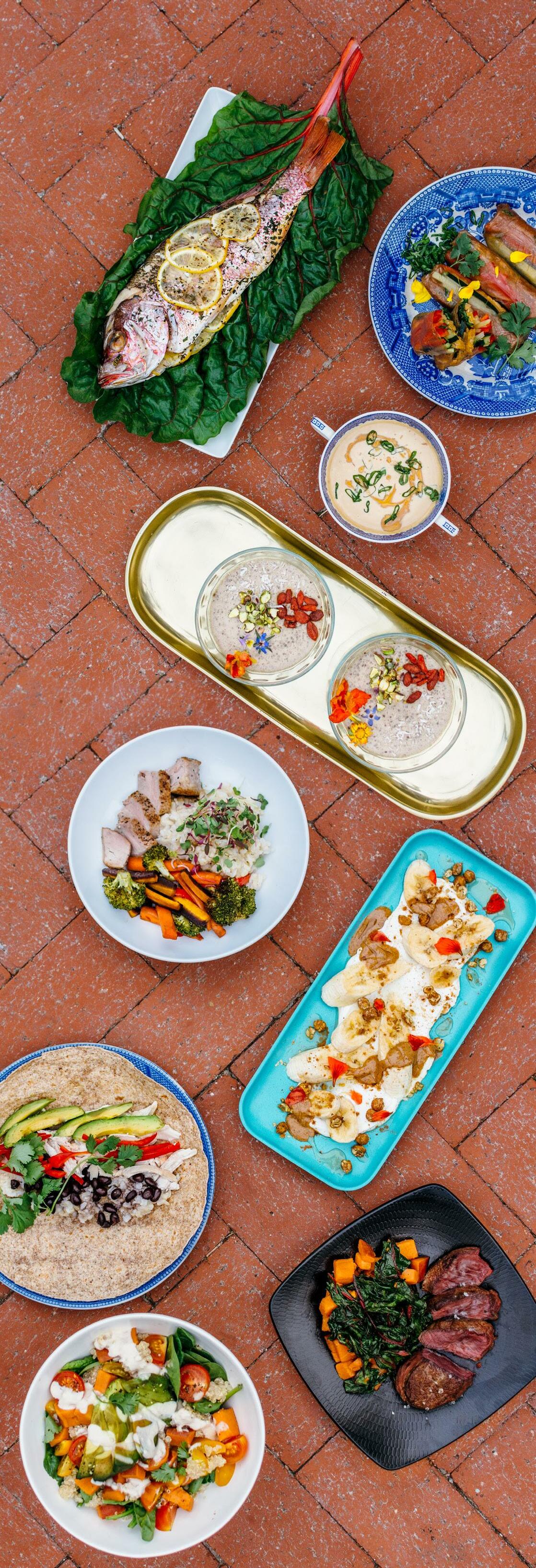
Joni Hargrave is a Leucadia-based writer and lover of food, travel, and slow fermented sourdough baking. Constantly on the hunt for pockets of adventure, she scouts San Diego neighborhoods for new flavors, hidden gems, and unique experiences. Follow her on Instagram @jonpon12.
Maria Hesse is Edible San Diego’s managing editor, a food and lifestyle designer, pug photographer at PugsMutt.com, and co-author of The Intentionalist Cooks! You can find her on the World Wide Web at MariaHesse.life or get in touch at maria@ediblesandiego.com.
Packing enough protein into a plant-based diet is often considered a challenge for those who don’t know better. Both plant and animal proteins contain 22 amino acids that are said to be structurally equal aside from the simple fact that one comes from an animal and one comes from a plant.
The benefits of consuming plant-based proteins are numerous, ranging from increased fiber intake to an ample supply of antioxidants and phytonutrients, all leading to overall improved health. Strictly plant-based eaters brag about superficial benefits like clear and glowing skin and
improved mood and energy. If you choose to eat meat, it’s been proven beneficial to lean heavily on plants—like when following a flexitarian or reducetarian diet, or putting an occasional Meatless Monday on your calendar.
While vegan or plant-based eating is generally low-calorie and found to be
sufficient in supporting excess weight loss, special efforts should be made to ensure that vitamins like B12, calcium, iron, and zinc are incorporated. You can make sure to get enough B12 by eating fortified foods or taking supplements daily, while calcium, iron, and zinc can come from soy and other beans, whole grains, nuts, and seeds. Essential fatty acids, such as omega-3s, can be consumed in leafy greens, beans, seeds, and hard winter squashes.
Medical evidence has shown that maintaining a well-balanced vegan diet improves kidney function and blood sugar levels while decreasing blood pressure, risk of heart disease, and certain cancers. Documentary films like Forks Over Knives (Monica Beach Media, 2011) have even demonstrated how vegan diets can reverse critical conditions in patients with type 2 diabetes and heart disease.
By eating more plants, you may be able to effectively reduce your carbon and water footprints. The EPA reports that 9% of greenhouse gas emissions come from agriculture, a third of which comes from methane produced by livestock. And it’s estimated that it takes 1,800 gallons of water to produce a single pound of beef. Your dependency and contribution to such outputs are zero if you avoid them.
Our year-round access to fresh vegetables and fruits doesn’t necessarily mean there is an abundance of protein-dense vegetable crops like grains, beans, and nuts cultivated locally. Many of these crops are sourced easily from Central Valley growers, like Hopkins AG, beloved at local farmers’ markets for their nonpareil supreme unpasteurized almonds grown on 3,000 acres in the San Joaquin Valley.
RECIPE S
Recipe by Kelly Redfield, Bastyr University California nutrition student
Prep time: 40 minutes
Serves 1
Loaded with fiber-rich vegetables, this sweet and savory bowl is perfect for those looking to get in some extra plantbased protein. And with only 6 simple ingredients, it takes little effort to put this plant-powered bowl together. Quinoa’s superfood reputation holds true: As a seed, it contains all 9 essential amino acids, while 1 cup of cooked quinoa provides 8 grams of protein.
Preparation tip: For even more flavorful quinoa, cook it in low-sodium vegetable stock instead of water.
1 small sweet potato, cut into ½-inch cubes
1 cup fresh spinach
½ cup quinoa, cooked
¼ avocado, sliced
½ cup cherry tomatoes, quartered
1 tablespoon tahini
½ lemon, juiced
Salt and pepper to taste
If you’re interested in growing your own plant proteins, might we suggest fava and garbanzo beans: Not only do they look lovely in a garden, they also dehydrate and store well. Like other legumes, they’re nitrogen correctors and are said to flourish for home growers in the region. If you’re putting beans in your garden for the first time or you’re having growing difficulties, check out Joyce Gemmell’s Veggie Guide on the San Diego Master Gardener Association website for tips. Prime planting season starts in April.
Specialty Produce is a great place to buy California-grown quinoa and rice. For locally made tofu, look out for the good stuff made by San Diego Soy Dairy at local grocers including Jimbo’s Naturally locations, Sprouts, Frazier Farms Markets, the Cardiff Seaside Market, and Boney’s in Coronado. D
Preheat oven to 425°F.
Place cuubed sweet potato on a baking sheet covered in parchment paper; bake for 30 minutes.
Assemble bowl by layering spinach, sweet potato, prepared quinoa, avocado, and tomatoes.
Drizzle tahini and lemon juice over the bowl, season, and enjoy.
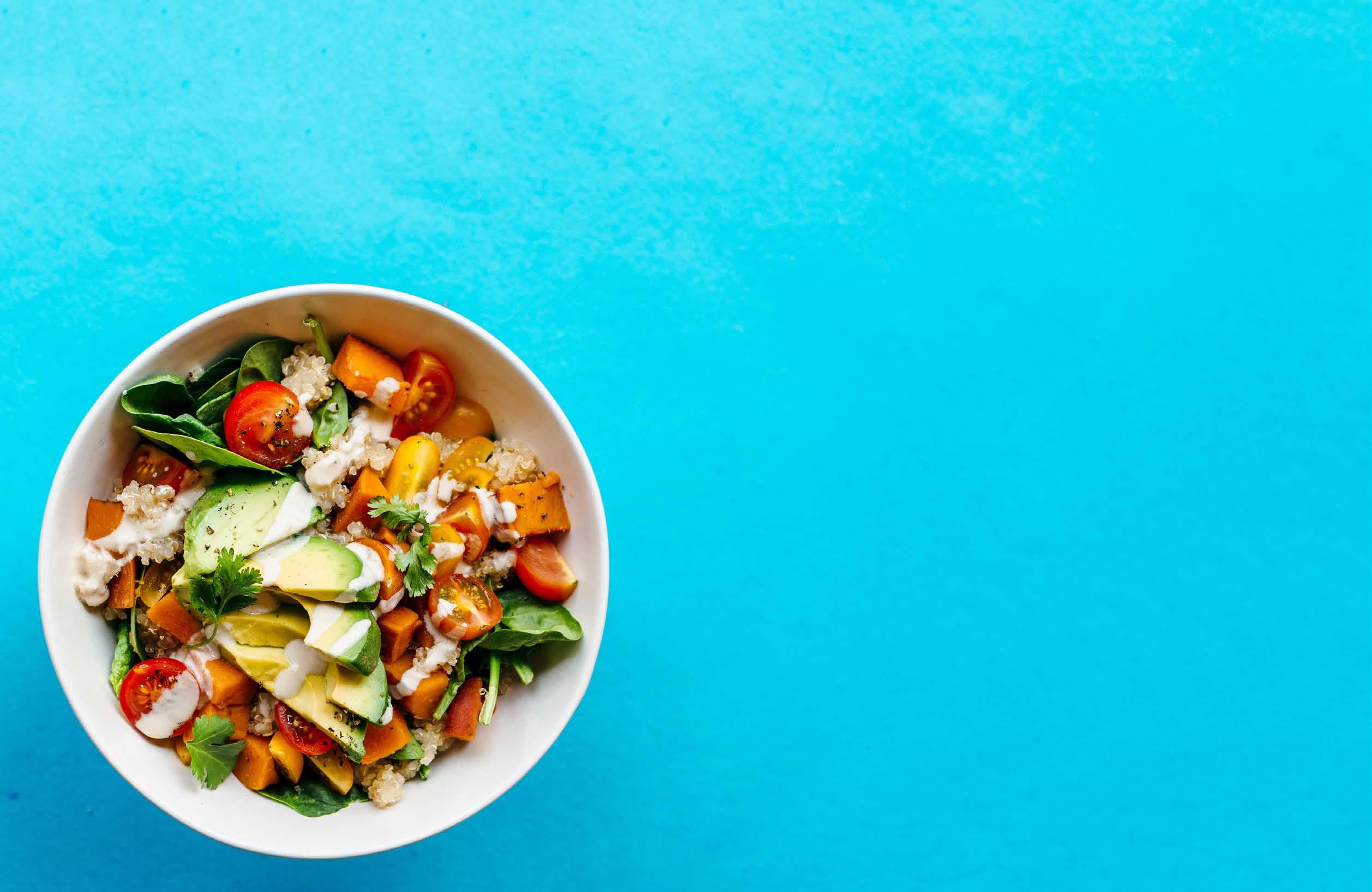
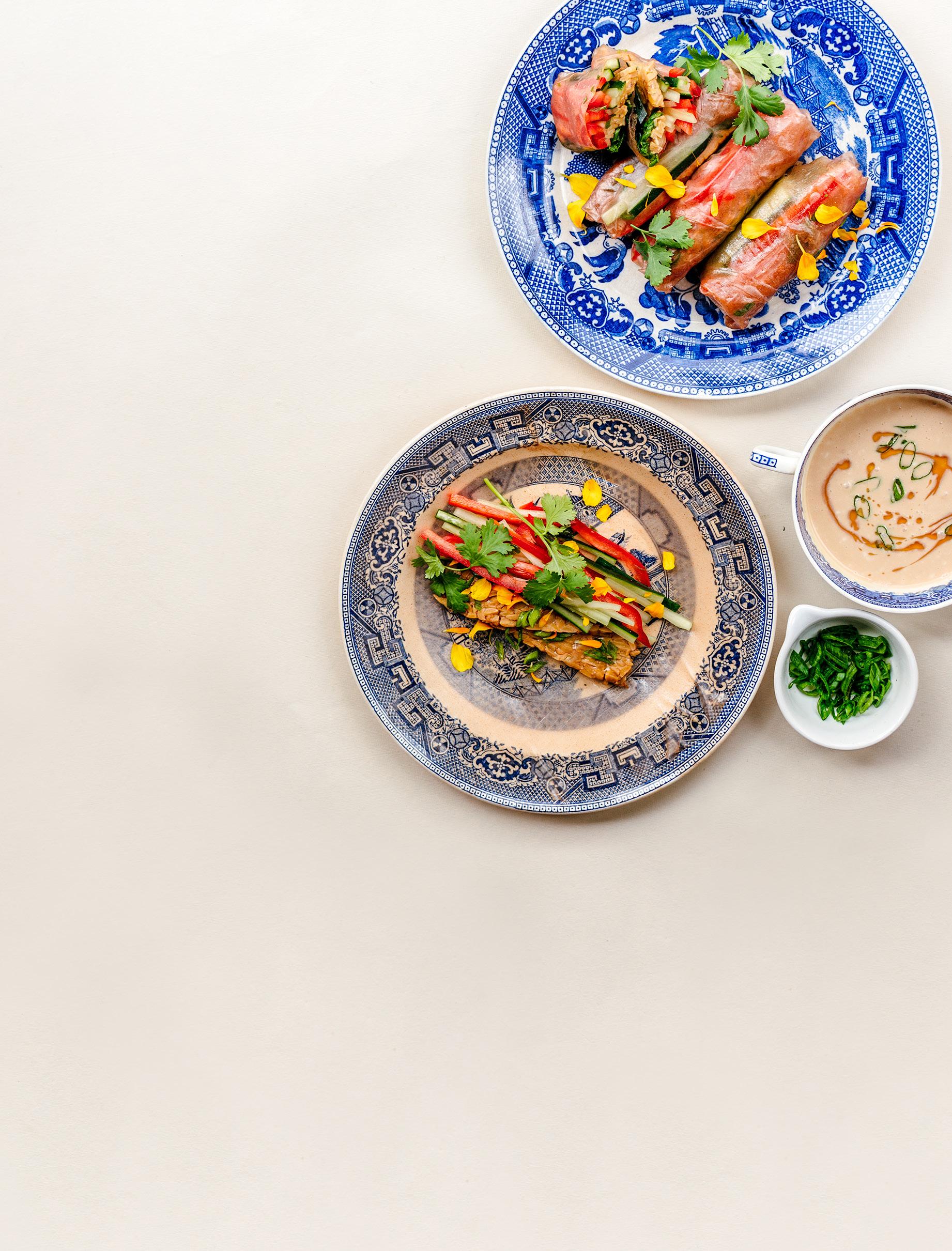 Recipe by Fernanda Larson, Bastyr University California nutrition faculty
Recipe by Fernanda Larson, Bastyr University California nutrition faculty
Prep time: 20 minutes
Serves 4
Soybeans have been consumed for centuries. The more recent introduction of GMO soy and its byproducts in the processed food industry gave soy a bad reputation. Going back to the way our ancestors consumed it—organic, whole, pure, fermented—is a sure way to add healthy, valuable plant protein to our diets. Half a cup of soybeans can provide 14 grams of plant protein.
These rolls are healthy, adaptable, and make a wonderful light dinner, lunch, or appetizer. Fill them with your favorite vegetables and herbs and serve with this creative dipping sauce!
Marinade
½ cup tamari sauce
2 limes, juiced
2 teaspoons freshly grated ginger
2 teaspoons toasted sesame oil
2 cloves garlic, mashed Spring rolls
½ pound tempeh, sliced lengthwise into 4 strips
4 large round brown rice paper wrappers
1 bell pepper, seeded and julienned
1 cucumber, seeded and julienned
4 scallions, trimmed
¼ cup cilantro leaves
Dipping sauce
Leftover marinade
1 cup coconut cream
In a large bowl, whisk together marinade ingredients; stir in tempeh strips and let sit at room temperature while you prepare the vegetables.
Fill a large, flat bowl with warm water, making sure the bowl is wide enough to fit the rice paper wrappers. Carefully dip a round wrapper into the water; remove and lay it out flat onto a clean surface.
Layer a small amount of bell pepper, cucumber, scallion, and cilantro on the bottom third of the wrapper and top with one tempeh strip. Fold up the bottom third, fold in the sides, and roll up the rest to make a burrito shape.
Transfer the leftover tempeh marinade to a small bowl. Stir in coconut cream and mix well. Add salt to taste. Serve as a dipping sauce. D
California Connection Tempeh was first made in the US by Mary Otten, who brought a recipe to make the highly nutritious fermented soy product with her after immigrating from Indonesia to the Bay Area during World War II. The caterer started making tempeh in her basement with her daughter in 1961, and it gained popularity at Bay Area health food stores in the form of ready-to-eat Indonesian dishes like Sayur Lodeh Tempeh and Sambal Goreng Tempeh.
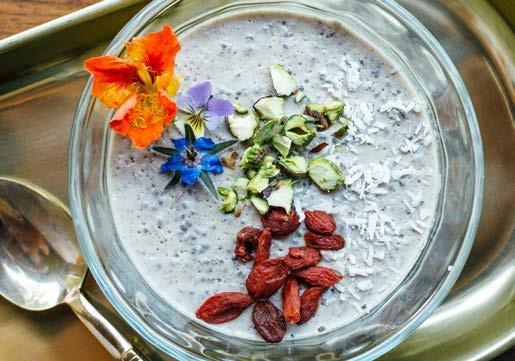
Recipe by Devon Cassidy, Bastyr University California nutrition student
Prep time: Less than 10 minutes, plus thickening time (30 minutes) Serves 2
Nuts and seeds are nutritional powerhouses mostly known for their healthy fat content. Versatile and interchangeable in recipes, they are also great sources of minerals, fiber, and protein. Pumpkin seeds provide 8 grams of protein per ounce, plus plenty of iron and magnesium. Almonds provide 6 grams of protein per ounce and are rich in calcium and fiber.
Store whole raw nuts and seeds in a sealed container in the freezer to best preserve their nutritional value.
⅓ cup chia seeds
½ cup hulled pumpkin seeds
1 ½ cups water
1 banana
2 tablespoons almond butter
2 tablespoons maple syrup
Optional toppings: fresh or dried berries, cacao nibs, cinnamon, dates, coconut flakes, nuts
Spoon chia seeds into a Mason jar or small serving bowl.
Prepare pumpkin milk by blending pumpkin seeds with water in a high-speed blender; add banana, almond butter, and maple syrup to the pumpkin milk and blend until well mixed.
Pour mixture over chia seeds and stir.
Place in refrigerator and let thicken for at least 30 minutes or overnight.
Add additional toppings as desired.

Bachelor
Provides a whole-foods, holistic approach to nutrition
Gives you an in-depth knowledge of food, nutrients, biochemistry and research analysis
Classes in areas such as menu design and therapeutic cooking
To learn more go to Bastyr.edu/BSNCA or call 858.246.9700
What if your nutrition degree could train you to prepare meals that inspire health and wellness?








 By Joni Hargrave Photo by Olivia Hayo
By Joni Hargrave Photo by Olivia Hayo

perfectly balanced, affordable protein source, the egg boasts boundless uses as a breakfast staple, the brunch VIP (very important protein), and as the literal glue in the science of baking. Consumed around the world, the egg knows few boundaries and is the best part of many crowd-pleasing dishes. For the healthiest and best-tasting eggs, look for local, pasture-raised eggs whenever possible. Not only is this the best option for your community and for Mother Earth, but it’s the best thing for the hens. Happy hens lay incredible eggs.



Yielding six grams of high-quality protein per serving, whole eggs pack in quite a few impressive health benefits. While the egg white contains all protein, the yolk contains many essential nutrients, like selenium and zinc for proper thyroid and immune function.
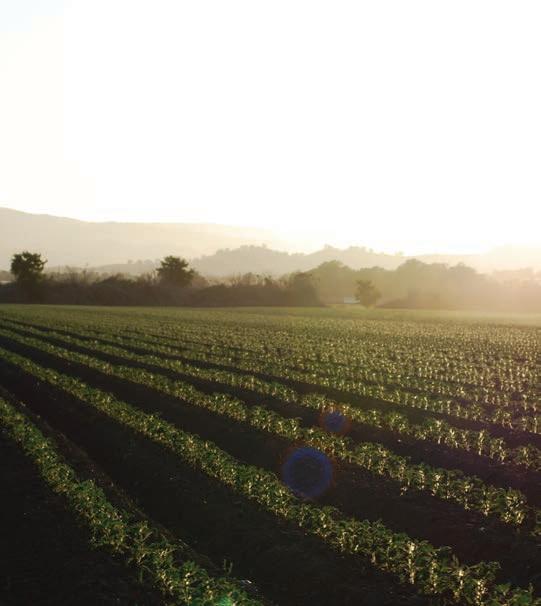
It’s estimated that the US consumes 250 eggs per person per year. Considering that our population has reached upwards of 300 million, it’s important to opt for the smallest carbon footprint possible by
purchasing local, ethically produced eggs from farmers committed to the principles of sustainable agriculture.


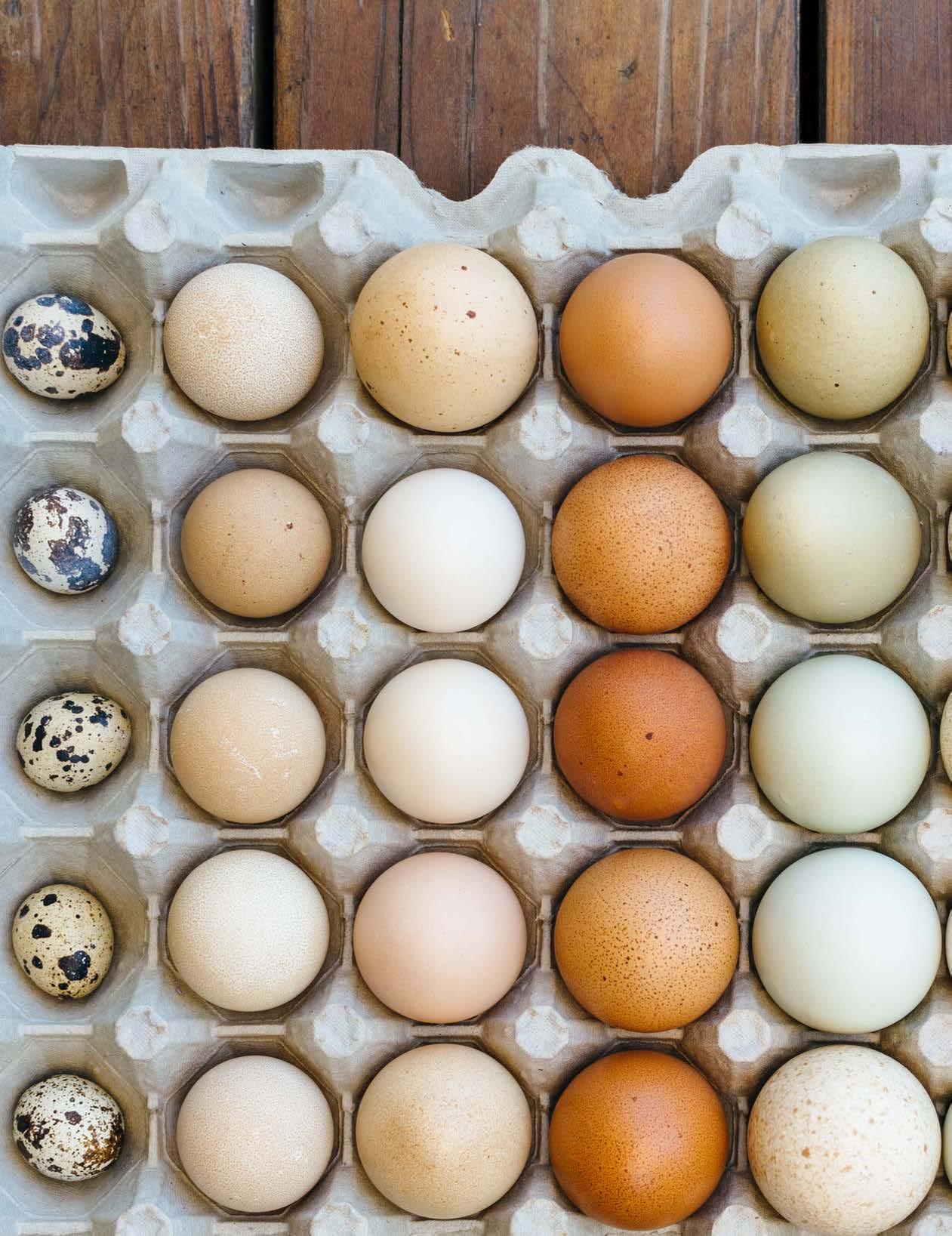



Da-Le Ranch Eben-Haezer Poultry Ranch
Markets
Jimbo’s Naturally Cream of the Crop Whole Foods Stehly Farms Market Restaurants
Lofty Coffee GoodOnYa Deli Nectarine Grove
Da-Le Ranch also offers quail, guinea, pheasant, duck, and turkey eggs.
Marketing has had a heyday with attention-grabbing callouts on egg cartons. Unfortunately, most of the phrases— particularly “cage free,” “free range,”
and “no antibiotics”—mean absolutely nothing. Thankfully, Chloe Nevarez of Eben-Haezer Poultry Ranch has some helpful tips to ensure you are purchasing the highest quality eggs that are handled by humans, not machines.
• First and foremost: Know where your eggs are coming from. Who’s the farmer? Can you call them? Can you visit the farm? Transparency is key.
• Pasture-raised: This phrase is often misused for marketing purposes. If the claim is true, however, that means hens—like our hens—are outside and free to roam 100% of the time. EbenHaezer hens are even rotated regularly for access to fresh foraging and to boost soil regeneration.
• R eference the Cornucopia Institute: If you are limited to major supermarket chains, visit this online egg scorecard to see how various brands rank. We are proud to claim our ranch ranks #2 in the nation.
cornucopia.org/scorecard/eggs/
Within the category of dairy lies a list of alluring foods derived from milk, ranging from butter to cheeses to yogurt and cream. We generally consume dairy products produced from cow’s milk, but alternatives like sheep, goat, and even camel’s milk are growing in popularity.
Despite years of bad press for having a high saturated fat content, recent studies suggest there is a lack of evidence linking conditions like heart disease to whole-fat dairy. There are 16 essential nutrients in milk, including high levels of bone and muscle builders like calcium, zinc, potassium, phosphorus, magnesium, and folate. Dairy produced from grass-fed cows are said to have a healthier balance of fatty acids and higher value of conjugated linoleic acid (CLA) that protects against type 2 diabetes, heart disease, and breast and colorectal cancers.
Approximately 75% of the world experiences lactose intolerance in adulthood, commonly affecting high percentages of populations in South America, Africa, and Asia. Individuals who experience difficulty digesting cow’s milk can sometimes consume sheep
or goat milk products with little to no complications. Lactose intolerance is not to be confused with a milk allergy, a condition increasing in prevalence over the past few decades, especially in children. Unlike lactose intolerance, which can cause symptoms of digestive discomfort, a milk allergy triggers anaphylaxis, causing symptoms like hives or rashes, and in severe circumstances, it can even be fatal.
It’s no secret that the large-scale commercial production of dairy leads to the production of greenhouse gases. Volatile organic compounds coming off the feed piles, plumes of ammonia rising up from manure lagoons, and waterways becoming contaminated with nitrogen and phosphorus runoff shed a different light on the efficiencies and low prices industrialscale dairy
production offers. If you add in animal welfare concerns, smallscale dairy production starts to look better on every front.
There is a way to maximize dairy farming operations while lowering impact. Locally, Frank Konyn Dairy, the city’s last dairy farm, has been implementing sustainable practices such as manure management. The city and county’s renewed interest in promoting sustainable agriculture models in the San Pasqual Valley would benefit from the example set by Marin County. So far, the Marin Carbon Project has helped to develop and implement carbon farm plans for over a dozen farms, including large-scale commercial producer of organic dairy Straus Family Creamery. The project hopes to have carbon farm plans in action for 20 farms by 2020.
There are currently only two commercial dairy farmers in the county: the previously mentioned Frank Konyn Dairy in the San Pasqual Valley, and TD Dairy in Ramona. With roughly 1,500 milking cows between the two of them, both dairies are part of California Dairies, Inc. (CDI), a co-op of 400 California dairies that produce 43% of the state’s milk and 9% of the milk supply nationwide. CDI milk is primarily processed into butter and
Recipe by Maggie Wissler, Bastyr University California nutrition student
Prep time: 30 minutes Serves 1
While adults can achieve a balanced diet without consuming milk, some forms of dairy can be great additions to our meals: Fermented yogurts and kefirs can be a source of live beneficial bacteria, and fermentation makes dairy easier to digest and more nutritious. Look for organic whole milk yogurt with labels that state “unpasteurized” or “with live cultures.”
Greek yogurt contains all essential amino acids, and a typical 6-ounce serving provides about 20 grams of protein.
In this recipe, protein-packed Greek yogurt blends with rich almond butter to create a creamy spread. Cinnamon-toasted chickpeas top off this breakfast ensemble with a crunch.
powders. The butter is often sold by brands like Challenge and Danish, or used in store brands like Kirkland for Costco and Trader Joe’s. Nestle uses the milk powder for infant formula. And some of the milk goes into cheese.
Speaking of cheese, if you’re an aspiring cheesemaker, find all the supplies you need at Curds and Wine, a local cheese and winemaking shop on Clairemont Mesa Boulevard. You could also join a cheesemaking club, like Queso Diego. Otherwise, the California Cheese Trail offers great incentive for a cheese-inspired vacation, listing over 70 California cheesemakers that can be toured from Crescent City to Los Angeles.
For delectable, high-end cheeses of the extraordinary variety, you must go to any one (or all) of the four Venissimo Cheese locations in San Diego. Small Goods, a local farmers’ market vendor, is also noteworthy for creamy sheep’s milk fetas.
For an incredible locally made Greek yogurt, keep an eye out for Yallitizer’s at local farmers’ markets.
And, if by chance you’re looking for camel’s milk, check out the Oasis Camel Dairy in Ramona. D
¼ cup canned chickpeas, drained, rinsed, and dried
2 teaspoons ground cinnamon, separated
3 ounces plain, whole-milk Greek yogurt
2 tablespoons almond butter
1 large banana, peeled Honey, optional
Preheat oven to 375°F.
On a parchment-paper lined baking sheet, evenly spread chickpeas and sprinkle with 1 ½ teaspoons cinnamon. Place in oven and bake for 25-30 minutes, depending on desired texture.
While the chickpeas are roasting, combine Greek yogurt with almond butter in a small bowl. Mix until smooth and well combined.
Place whole banana onto a plate or slice into bite-sized pieces. Spread yogurt mixture over banana.
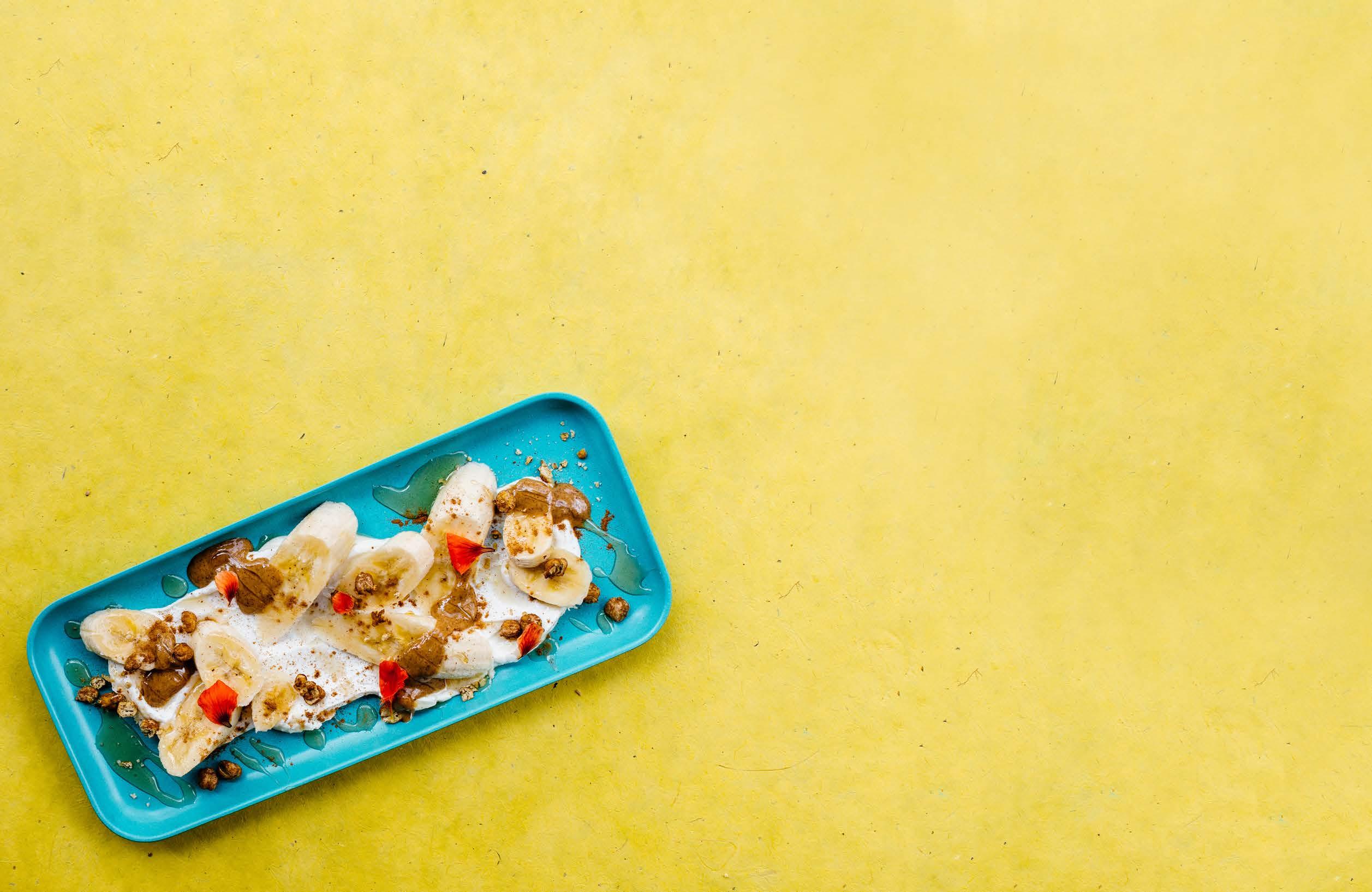
Top with remainder of cinnamon and toasted cinnamon chickpeas.
Recipe Note Add some honey to the yogurt mixture or drizzle some on top if you like your yogurt sweet.
Smoked, grilled, fried, roasted, poached, or raw, seafood is one of the most versatile proteins to prepare and your best source of those heart- and brain-healthy omega-3 fatty acids. From salmon to sea bass, wild-caught or farmed, it’s never been easier (especially in San Diego!) to embrace a low-carbon lifestyle and eat local, fresh-off-the-boat fish. Community-supported fisheries and restaurants are coming in hot, so find a local fishmonger for first dibs on what’s biting from North County to Baja.
Shrimp and oysters from Baja, California king salmon (seasonally), white sea bass, herring, red snapper, varieties of tuna including Pacific bluefin, squid, crab, lobster, mackerel, and halibut
This high-protein, mineral-rich food has a rightful place in a well-balanced diet. Though each breed yields brain-body benefits, zinc, iron, and omega-3s (the essential “good” fats humans don’t produce on their own) rank at the top. Opt for seasonal,
low-mercury fish two to three times a week, and limit your consumption of high-mercury fish to no more than 12 ounces per week, according to the USDA.
Fish populations, water pollution, and habitat degradation are all real concerns in our marine environments. Understanding where your fish is coming from, what your local fish stock is, and how it was caught will not only yield better-tasting fillets, but will also contribute to a necessary sustainable seafood movement. While some large-capacity commercial vessels, known as trawlers, practice sustainable fishing, small-scale fishermen leave only the slightest trace, employing smaller boats and lower-impact methods like hook and line (literally catching one fish at a time).
So what’s the most sustainable seafood on the market? While abundance varies with the seasons, try Pacific-bound, feel-good varieties like shrimp, oysters, yellowtail tuna, halibut, and Pacific snapper.
Markets
Catalina
Over the past seven years, fisherman, diver, surfer, restaurateur John Park of Fish 101 has been sourcing high-flavor, low-impact fish
for his sustainable seafood eatery by way of local, hook-and-line fishermen. If you can’t make it to his Leucadia-based restaurant, use John’s tips to ensure you get the freshest catch every time.
• Look for the country of origin: Consumer law regulated by the USDA requires all commercial retailers to label wild and farmraised fish with country of origin labeling (COOL).
• Look for FAS (Frozen at Sea): This designation means strict adherence to quality, assuring the fish is as fresh as the moment it left the sea.
• Know your local fish:Talk to a local fishmonger or do a little Googling for a calendar of what’s biting when. White sea bass, halibut, yellowtail, and bluefin tuna are rotating favorites. D
RECIPE
Recipe by Fernanda Larson, Bastyr University nutrition faculty
Prep time: 45 minutes
Serves 2-4
Pacific red snapper is a local fish widely available during the summer months. The fish’s delicate flavor is highlighted by fresh lemon and herbs. The use of parchment paper as a baking vessel not only preserves the nutritional value and flavor of the fish, but also makes for a sophisticated presentation and easy cleanup! A 3-ounce serving of fish provides an average of 20 grams of lean, complete protein.
2 tablespoons fresh parsley
2 tablespoons fresh oregano
2 tablespoons olive oil
Salt and pepper to taste
1 whole small Pacific snapper, scaled and gutted
1 whole lemon, thinly sliced, plus wedges for serving Parchment paper
Preheat oven to 400°F.
Finely chop parsley and oregano and transfer to a bowl with olive oil, salt, and pepper; stir. Make 3 shallow slits on each side of fish and rub ¾ of the fresh herb mixture all over. Lay lemon slices over each slit and add a few slices with the remaining herb mixture to fish’s cavity. Cut parchment paper into a large enough piece to comfortably wrap fish. Make a papillote: Lay fish on the parchment paper, fold two opposite sides up over the fish, and bring the other two sides together, rolling down toward the fish, making sure it stays in place. Place papillote on a baking sheet and bake for 20 to 30 minutes depending on the size of your fish.
Dress the snapper with more lemon juice and cracked pepper to serve.

Paul Greive of Pasturebird is the world’s largest producer of true pasture-raised chickens (not far from us in Murrieta) and advises that picking a good bird comes down to one simple idea: Know your farmer.
While pasture-raised is the buzzword of the moment, the term is not federally regulated, so just about anybody can use it, whether the animals see a blade of grass or not. Get away from relying on labels and get back to relationships with farms and farmers
themselves—go online, check out websites and Instagram feeds of the farms, or find a farmers’ market and chat with the ranchers in person when you can. A pastured bird may cost more, but it’s worth seeking for flavor and a lower carbon footprint.


Praised for its impressive protein profile (a 3-ounce chicken breast contains 27 grams of complete protein), America’s
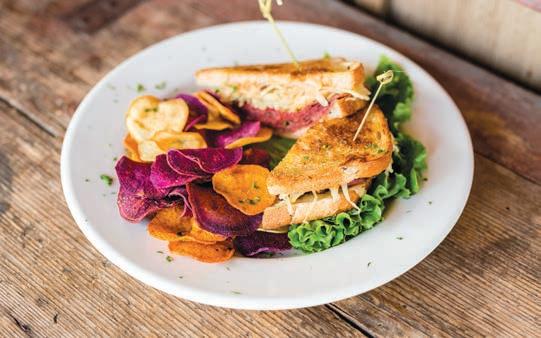
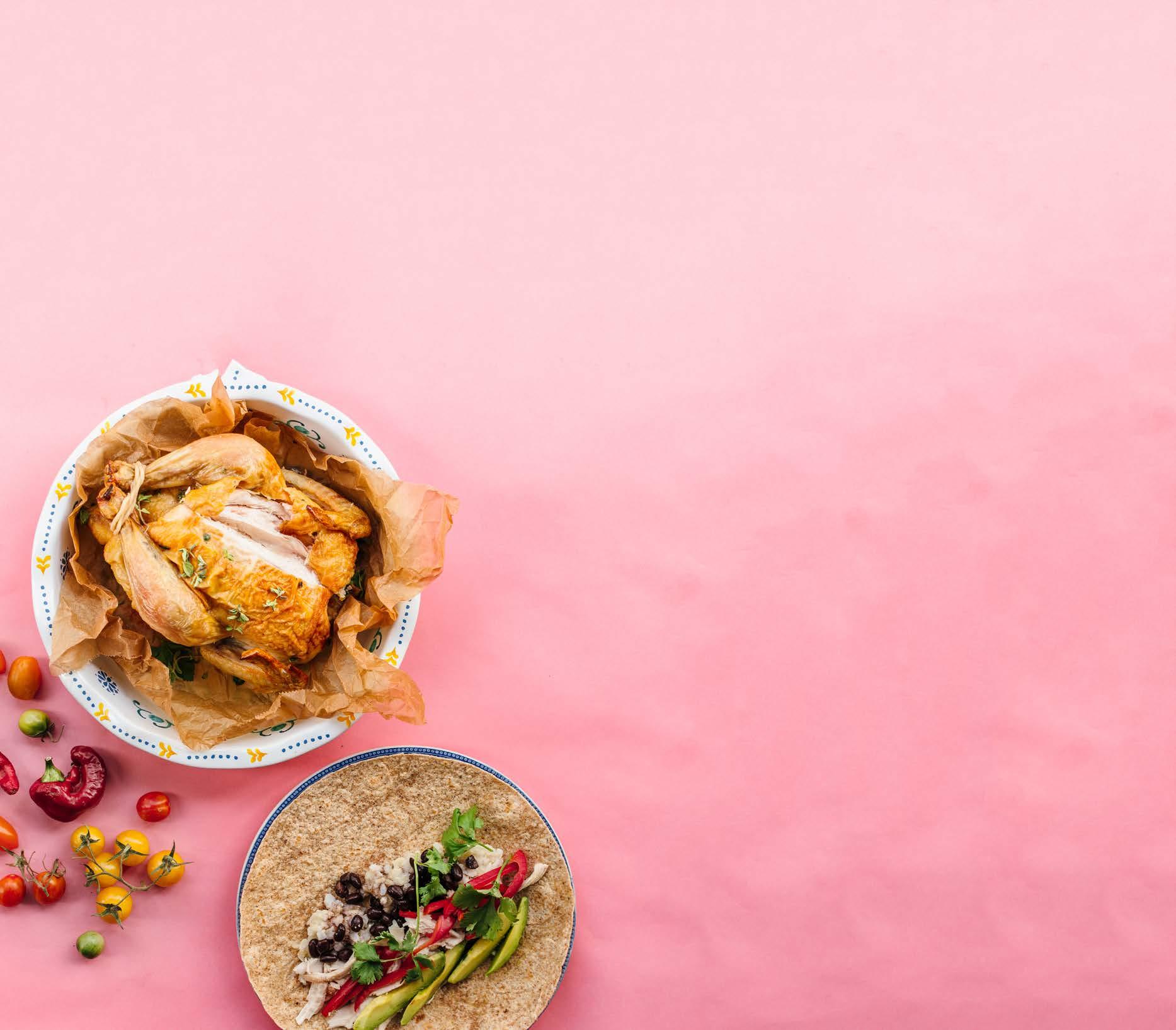
favorite white meat is also teeming with powerful nutrients, like energizing B vitamins and cancer-fighting vitamins A, C, and selenium. Next time you prepare poultry, be sure to leave the skin on— not only does it result in a juicier, more flavorful bird, it also packs in heaps of heart-healthy unsaturated fat.
To keep up with the demand for this lean protein, industrial chicken facilities have been pumping out poultry and pollution on a massive scale for years. Due to concerns of health- and environmentconscious consumers, small-scale farms are making a comeback with organically fed and free-roaming birds.

Farms
Da-Le Ranch
Pasturebird (chickens are available for wholesale or online at crowdcow.com/ ranch/pasturebird)
Stehly Farms Organics (get ready to order your holiday turkeys)

Heart & Trotter
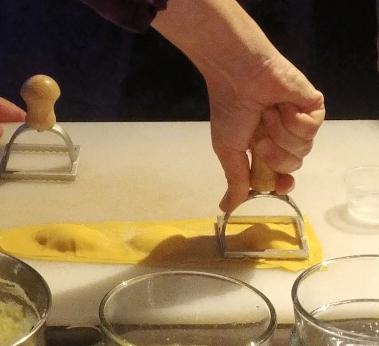
Specialty Produce (they have a variety of frozen meats from Alpine Meat Farms)
Stehly Farms Markets
Restaurants
GoodOnYa
Herb & Wood

Nate’s Garden Grill D
Prep time: 5 minutes Serves 1
A versatile ingredient, poultry is the most popular animal protein in the US. On average, Americans consume over 100 pounds of chicken and turkey per person per year. A chicken breast provides about 35 grams of complete protein per 4-ounce serving, but choosing the best quality meat is key. This simple wrap packs a protein punch in minutes! Kick up the antioxidant power and boost energy with fresh bell peppers and avocado to help you absorb essential fat-soluble vitamins. You can prepare the chicken (or a turkey breast) ahead of time by brushing with olive oil and roasting with ½ cup white wine or water in a 325°F oven for 2 ½ hours, or until the internal temperature reaches 165°F. Shred the meat with a fork and store in the fridge until needed. And give your wrap extra kick by seasoning the chicken with jalapeño peppers, garlic, and onion; in a pinch, use chili powder, cayenne pepper, garlic powder, and onion powder.
1 ½ ounces cooked and shredded chicken (or turkey), seasoned with salt and pepper to taste ¼ cup cooked brown rice ¼ cup cooked black beans
1 bell pepper, sliced ¼ avocado, diced
1 medium whole wheat tortilla
Wrap chicken, rice, beans, bell pepper, and avocado in a tortilla and roll it up like a burrito and enjoy!
At this tastemaker event 30 local and national celebrity chefs and mixologists will be competing to prepare winning dishes and cocktails using food that would otherwise be discarded. #WASTEDSD features renowned chefs & mixologists from Celebrity Chef Elizabeth Falkner, James Beard nominee Javier Plascencia, to Bravo TV’s Top Chef Katsuji Tanabe and more.
The word verboten means “forbidden”— which means more pork for those of us who adore it. I’ve heard dedicated vegans confess to eating bacon a few times a year because who could resist that distinct, succulent smell. Or carnitas. Or BBQ ribs with a side of pork and beans. Or a pile of prosciutto with fresh sliced melon. There’s good reason why there are so many devotees to the unholiest of meats. Like other livestock, when a pig is raised in a manner that respects both the animal and the environment, the only appropriate next step is to be grateful and enjoy it.

Evidence shows that pork and other meats have enriched nutritional value when pasture-raised. The higher levels of healthy fatty acids like omega-3s and conjugated linoleic acid (CLA) are great for your skin—plus, CLA promotes muscle building and weight loss. Pasture-raised pork also boasts a lower calorie content compared to conventionally raised pigs.
Conventional pork generally refers to pigs raised in a concentrated animal feeding operation (CAFO). Being raised in a CAFO means that pigs spend their lives indoors in confined facilities, and eat heavy loads of feed corn and soy with a side of antibiotics and hormones. While the USDA report of declining sales of antibiotics for foodproducing animals in 2016 is a shift in the right direction, it’s not enough to quell concerns from scientists around the world and even the Center for Disease Control that the overuse of antibiotics in food animals could lead to the creation of resistant superbugs that threaten public health.
Pasture-raised implies that the animal is raised outdoors and has free range, with

little to no supplemented feed, and is free of antibiotics and hormones. Krystina Cook of Cook Pigs (the woman behind the heritage pork prepared by chef Brian Redzikowski of Kettner Exchange who took home the regional Cochon 555 trophy back in March) says that “because the animals are working their [natural] feed into their muscles, the meat has better marbling and a richer, deeper flavor.”
Da-Le Ranch and Sage Mountain Farm are some of the more accessible pastured pork producers for Southern California
consumers, with a variety of meats available for sale at farmers’ markets and for order online. Cook Pigs has moved their herd from Alpine to Petaluma for greener pastures, but still sells whole heritage pigs to local butcher shop Heart & Trotter, and direct to local restaurants like Kettner Exchange, Juniper and Ivy, Born and Raised, Mister A’s, and Cowboy Star. Stehly Farms is also favored for their pigs by several San Diego chefs, as is Taj Farms. And, for thick slices of antibioticand hormone-free bacon, go see the butcher at Valley Farm Market in Spring Valley. D
Recipe by Kacy Lindaman, Bastyr University California nutrition student
Prep time: 30 minutes
Serves 1
Pork tenderloin is classified as “extra-lean,” meaning it contains less than 5 grams of total fat and no more than 2 grams of saturated fat per 3.5-ounce serving. The same 3.5-ounce serving provides about 30 grams of protein.
1 cup broccoli florets, roughly chopped
3 ounces rainbow baby carrots, sliced
½ red bell pepper, cut into strips
2 teaspoons olive oil, divided 2 cloves garlic, minced
1–2 tablespoons of Bragg’s Liquid Aminos
Salt and pepper to taste
1 ½-ounce pork tenderloin, lean cut 1 cup cooked brown rice
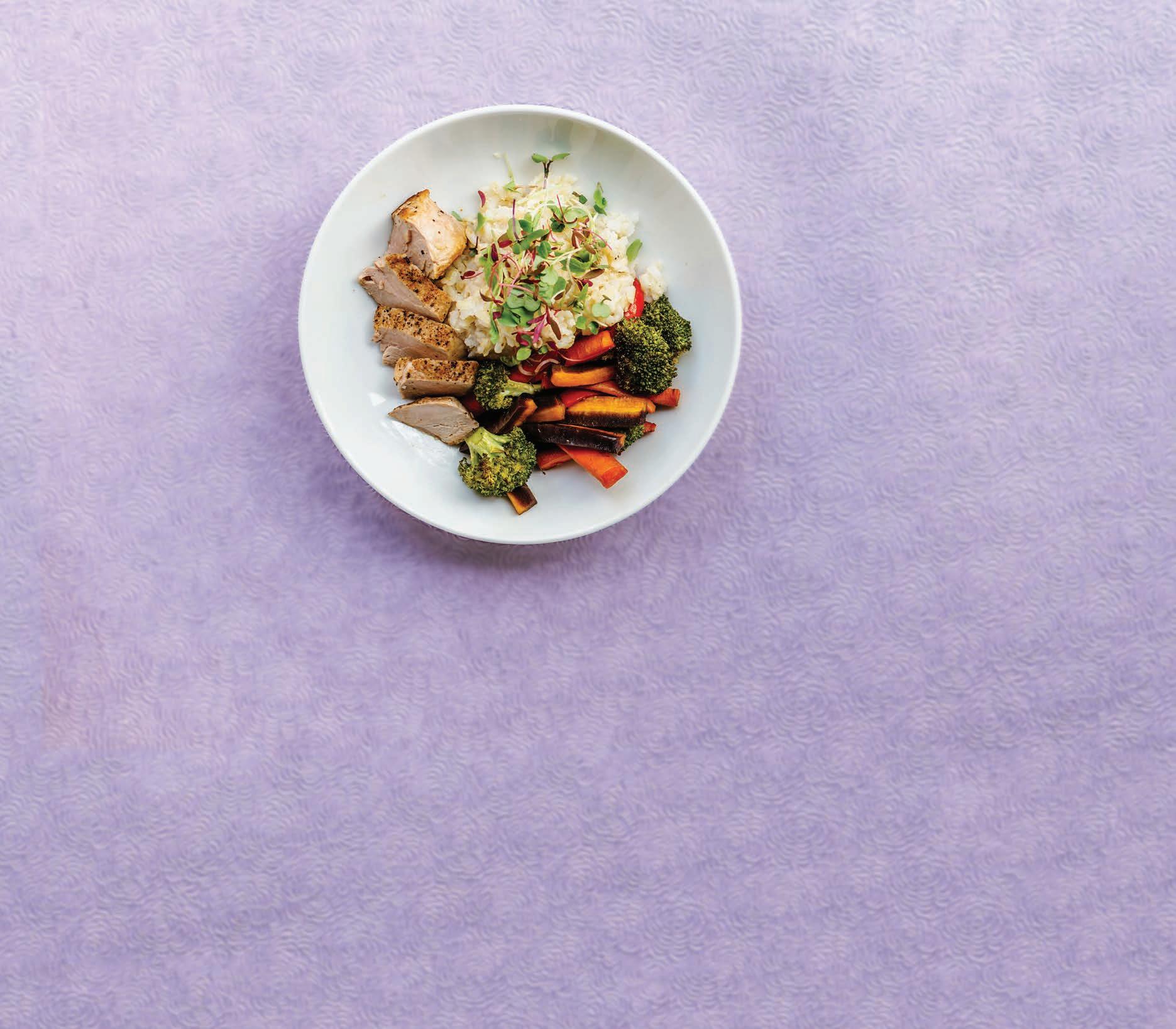
Preheat oven to 375°F.
Toss broccoli, carrots, and bell pepper with oil, garlic, Liquid Aminos, salt, and pepper. Place veggies on a sheet pan and cook in oven for 20 minutes, turning halfway through.
While veggies are cooking, slice tenderloin lengthwise into 2-inch medallions; season with salt and pepper. Heat an oven-safe skillet* on the stove over medium-high heat. Coat the bottom of the pan with remaining olive oil, add pork medallions, and sear one side until nicely browned, 3–5 minutes. Flip and sear the other side until lightly browned, 2–3 minutes. Remove pan from heat, cover, and transfer to the oven until thoroughly cooked, about 10–12 minutes. Assemble rice, vegetables, and tenderloin on a plate and enjoy!
*If you don’t have an oven-safe skillet, transfer meat to a baking sheet.
luckybolt.com

Mention this ad for a free trial lunch.
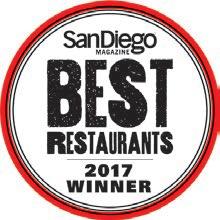
• Best Chef Winner, Accursio Lotà
• Best Wine List Winner
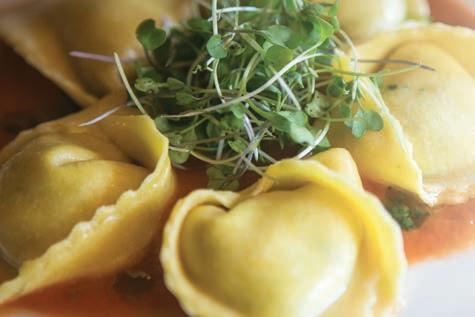
• 2017 Pasta World Championship Winner, Accursio Lotà
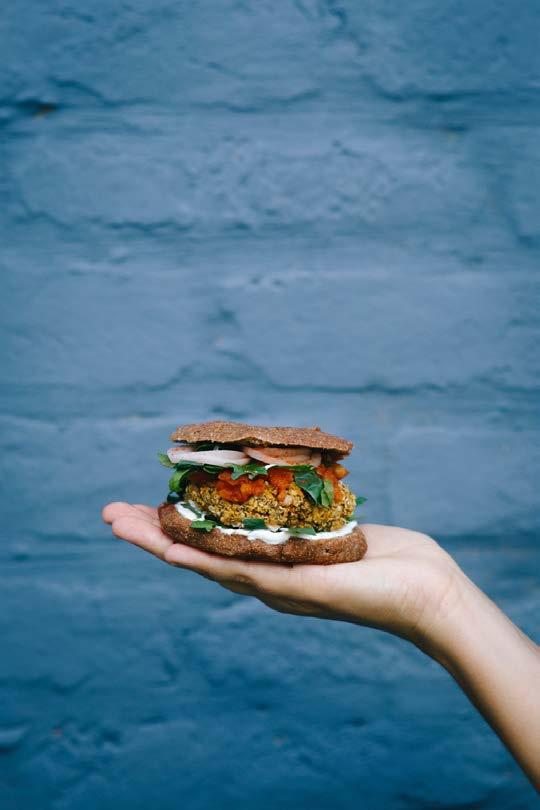
Local organic produce, meat & seafood
Authentic Italian cuisine Food, wine & spirits pairing events
Patio dining Dog friendly
Eat healthy when you’re busy. BETTER FOOD AT WORK 2820 Roosevelt Road • Liberty Station, Point Loma • 619-270-9670 • solarelounge.com
here’s the beef?” takes on a whole new meaning when you’re looking for ways to source beef raised within San Diego County. What can we say— raising livestock, like agriculture in general, is becoming increasingly challenging to maintain in our region. The cost of land, water, and labor and very slim margins for profit are the primary factors contributing to the swell of local farmers shutting off their water, uprooting groves of avocado and citrus trees, selling off land and herds that have been in families for generations, and shuttering doors. A summer of extreme heat has killed off desperately needed crops, and local producers need community support more than ever. We are not here to pour sugar on the reality.


Look for grass-fed beef free of antibiotics and hormones. Grassfed beef is sometimes grain-finished, which can be favorable for marbling and a richer flavor. Individuals looking to avoid grain-fed altogether should be sure to ask for grass-finished beef, which will
have yellower fat, a lower calorie content, and higher levels of antioxidants and fatty acids.


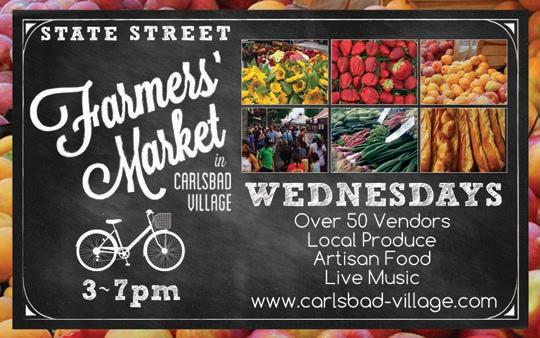
Just flip back a few pages to review the environmental issues that plague the dairy industry. Some might argue that this region may not be suitable for the large herds essential for the production of scale needed to turn a profit when it comes to beef production. But small-scale farms can benefit from small herds of livestock. When managed properly, food animals can be beneficial to promoting soil health and instrumental in comprehensive forms of regenerative agricultural practices. (While they don’t have cattle, you can take a tour of Stehly Farms to see how livestock can benefit organic agricultural practices.) As one small-scale farmer put it, the big barrier is the cost of processing cattle, or the lack of USDA processors suitable for small producers within close range. Having a few head of cattle would benefit both the health of this farmer’s land and her bottom line until she factors in the cost of transporting and processing. It would far exceed what she could hope to make selling the beef from a tent at a farmers’ market.
We are lucky enough to have the option of buying locally raised lamb at many of our favorite restaurants and markets. Goat is another red meat alternative that’s gaining in popularity with the increase of regional food tourism. Environmental impacts are decreased with smaller livestock herds.

Da-Le Ranch and Sage Mountain Farm meats are sold at many local farmers’ markets and available online. If you’re looking in a deli case, Heart & Trotter was the only butcher that we could find consistently offering California-raised grass-fed and grass-finished beef. Some local grocers like Jimbo’s Naturally, Sprouts, Lazy Acres, and Whole Foods are good places to find organic grass-fed beef and other meats. If you’re dining out, we encourage you to put your phones down, skip the drive-thru line, and sit down with your loved ones for a grass-fed cheeseburger at Burger Lounge, the popular chain that started in San Diego. They also offer lowcarb and plant-based options for your diverse friends, plus local beer and seriously tasty fries D
Recipe by Kevin Canale, Bastyr University California nutrition student
Prep time: 35 minutes
Serves 1
A 3-ounce serving of beef contains over 20 grams of protein and provides all of the essential amino acids necessary for feeling your best. Sweet potatoes are a source of vitamin A and potassium-rich Swiss chard gives our bodies the nutrients it needs to function optimally.
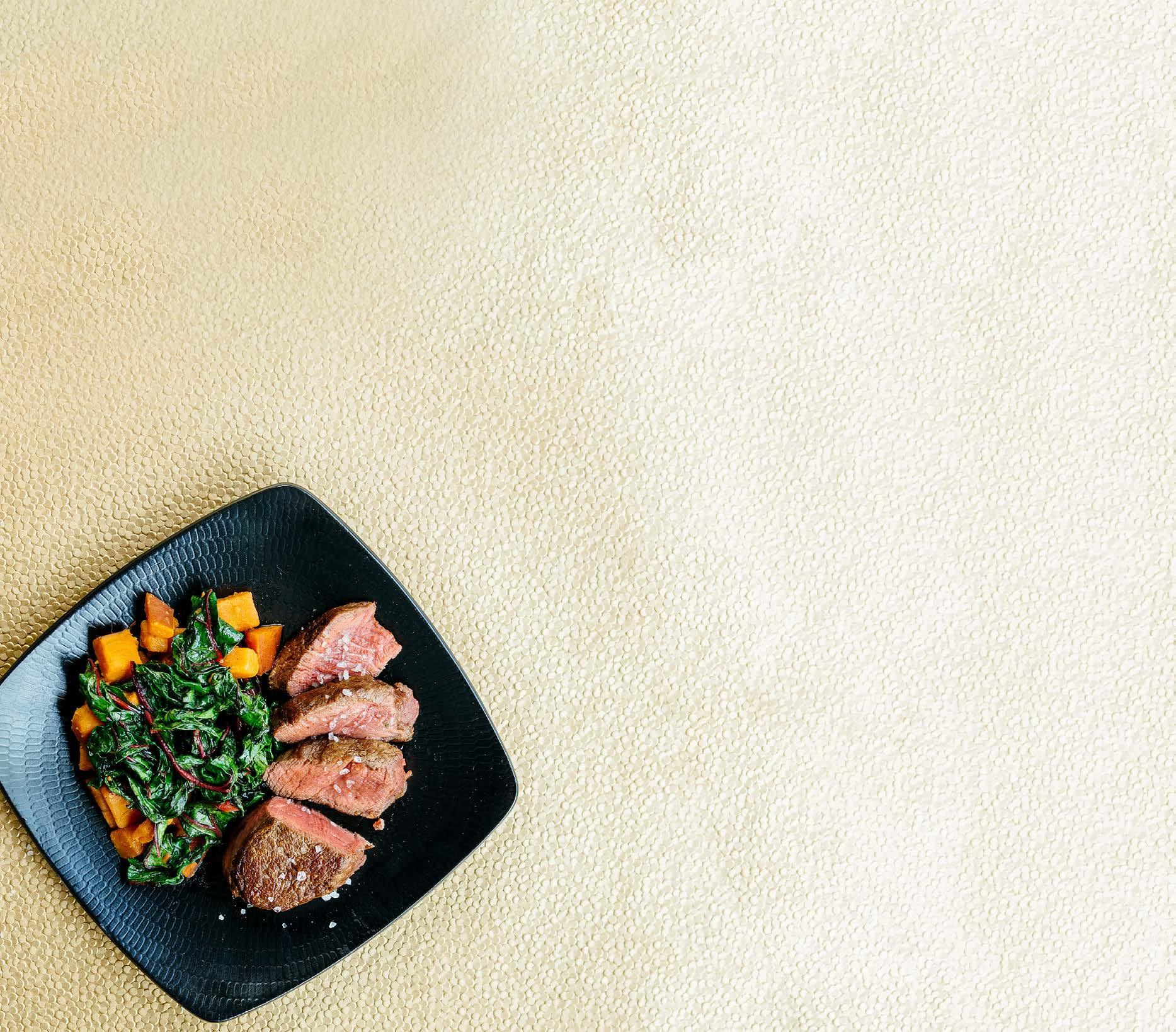

½ pound sweet potatoes, cut into ½-inch cubes
3-ounce filet mignon
2 tablespoons high-quality organic cooking oil of choice
1 cup Swiss chard, chopped
Salt and pepper to taste
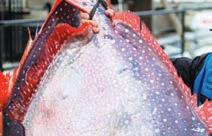
Preheat oven to 400°F
Fill a large pot with 3 cups of water and bring to boil. Add sweet potatoes. Cook for 20 minutes or until tender.
Heat an oven-safe skillet over medium-high heat and add 1 tablespoon oil. (Feel free to use a sodium-free rub for added flavor.) Place meat in pan once hot.
Cook filet on one side until nicely seared, about 3 minutes; flip and immediately place in the oven for 12 additional minutes or until preferred doneness is reached.
Heat another skillet on medium-high heat and add Swiss chard and 1 tablespoon oil. Saute for 3–5 minutes. Season the Swiss chard with a sprinkle of salt and pepper. Plate finished filet with Swiss chard and sweet potatoes and devour!
Editor’s Note: With all due respect to Kevin for creating this super-healthy recipe for filet mignon, we liberally salted and properly pan-seared the gorgeous beef tenderloin from Da-Le Ranch with a butter baste, rare to perfection, just for this photograph. However you prefer your beef or any meat, choosing to consume animals that are raised naturally, organically, humanely, and honestly—when you can and as much as you can—will make a difference.

It’s not news that raising livestock is one of the largest contributors to our planet’s ever-growing environmental footprint. There are options for meat that go beyond the usual suspects of beef, pork, lamb, and chicken. In fact, farmers and even chefs are shaking up sustainability with kinder cuts, featuring lesser-known sources of protein that are earth-friendly, efficient, easy to raise, and (bonus!) offer two to three times more protein than their more popular counterparts.
Boasting one of the highest percentages of digestible protein, rabbit is mild in flavor and, according to Slow Food USA, “can produce six pounds of meat on the same amount of feed and water it takes a cow to produce just one pound.”
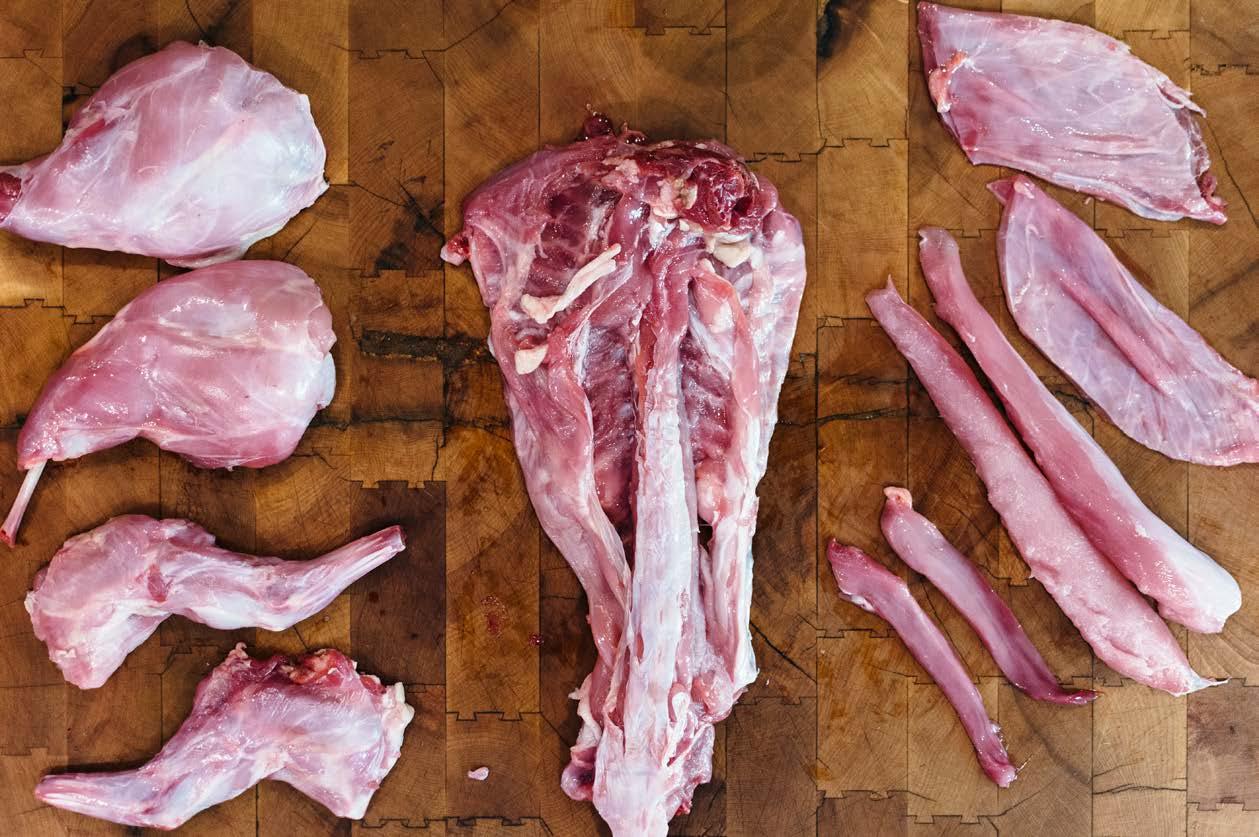
Not to mention, they breed like, well, you know...
Local Connections and Resources
Farmers’ Market
Thanks to Da-Le Ranch, you can grill with a little less guilt by picking up this pleasant protein at almost any San Diego farmers’ market. Order online at da-le-ranch.com
Restaurant
The Lion’s Share
Requiring only a gallon of water per pound, these nutrient-dense, low-impact chirpers are already enjoyed by 80% of the world.
With a taste described as a nutty medley of cashew, macadamia, and peanut, crickets are quickly forging the way for insect-eating acceptance with Westernized palates.
Try roasted crickets in stir-fries or add an extra dose of essential amino acids to your smoothies and baked goods in its versatile powdered form.
Are you ready to try these crunchy critters? Come on, live a little!
Local Connections and Resources
Farm
Coalo Valley Farms, California’s first urban cricket farm in Van Nuys
Restaurant
El Tejate
Bison
Calling all conscious carnivores: Buffalo meat could be just what the doctor ordered! Considered a heart-healthy protein powerhouse, this North American native contains fewer calories than beef, produces low carbon emissions, and actually helps preserve grasslands.
Even better news? You don’t have to visit Montana to get your fix. A slew of gastropubs throughout San Diego are reimagining the timeless burger with juicy, Midwest-meets-SoCal flair.
Local Connections and Resources
Farm Star B Ranch Market
Ramona Family Naturals
Restaurant
Pure Burger. All meat is locally sourced.

Small but mighty are these unsung heroes of poultry. An economic provider of protein for small farms and even backyards, quail is similar to chicken in flavor, yet quailsproduce more eggs, need less food and space, and mature much faster than their feathered friend.

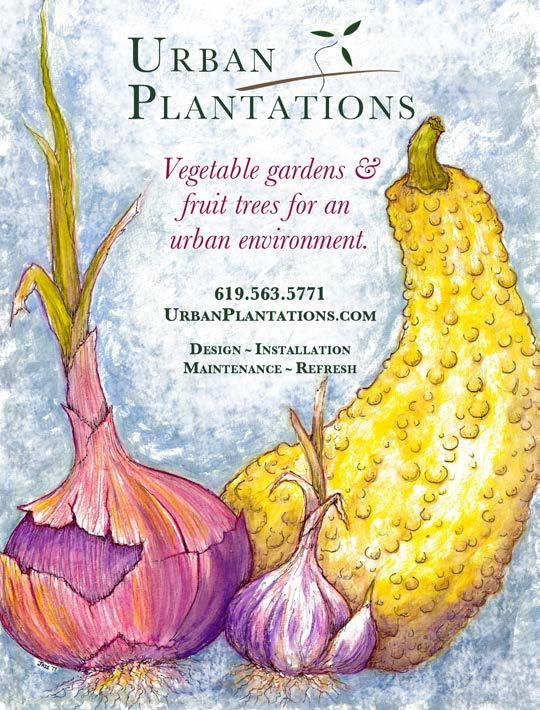
Local Connections and Resources
Farmers’ Market
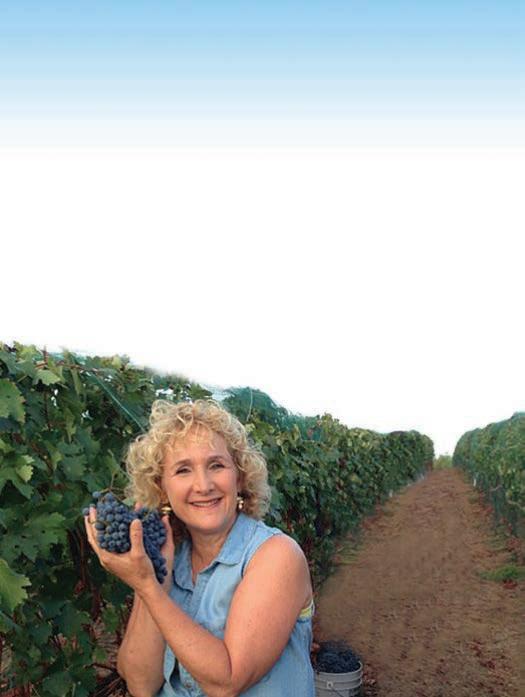
Buy from Da-Le Ranch at most farmers’ markets or order online at da-le-ranch.com.
The Lion’s Share (There are all sorts of interesting game meats on the menu, like rabbit, quail, and wild boar.)
Yakitori Hino (The menu offers quail eggs and occasionally meat.)


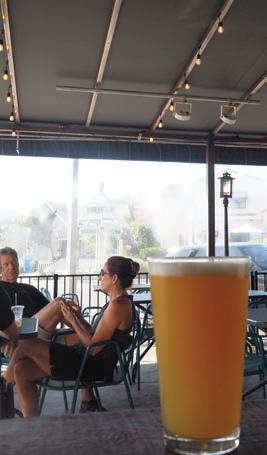 Story and photos by Jackie Bryant
Story and photos by Jackie Bryant
Though La Mesa lies just east of San Diego’s official boundary, it’s an easily overlooked neighborhood—which is unfortunate considering the new additions to the area’s drinking and dining scene over the last few years. Living by the beach, I’m especially guilty of overlooking La Mesa’s charms, so I decided to head a few miles inland for a day to see what I’ve been missing.
Nestled right in the middle of La Mesa’s main drag—the eponymous La Mesa Boulevard—is Public Square Coffee. In its description, the shop says what the world “needs is connection...Public Square is a place for exactly that.” Since I often find myself identifying with this need, I knew that Public Square was where my tour of La Mesa should begin. The cafe has an appealing and varied menu; I settled on a freshly baked scone with a “flight” of housemade maplecayenne, guava, and blueberry butters. To drink, I ordered my usual morning standard, a cappuccino, and took out my laptop to get some work done in the cheerful and creative space.

I decided to take a quick hike before it got too hot—and hiking is fairly easy to do in La Mesa with its variety of neighborhood hills and trails. Secret Stairs are somewhat hidden near the downtown area, but the popular climb can be found at the intersection of Canterbury Avenue and Windsor Drive, just a few blocks from University Avenue and La Mesa Boulevard. The hike up 245 steps is a real heart-pumper, but well worth the huffing and puffing: The summit boasts generous city views.
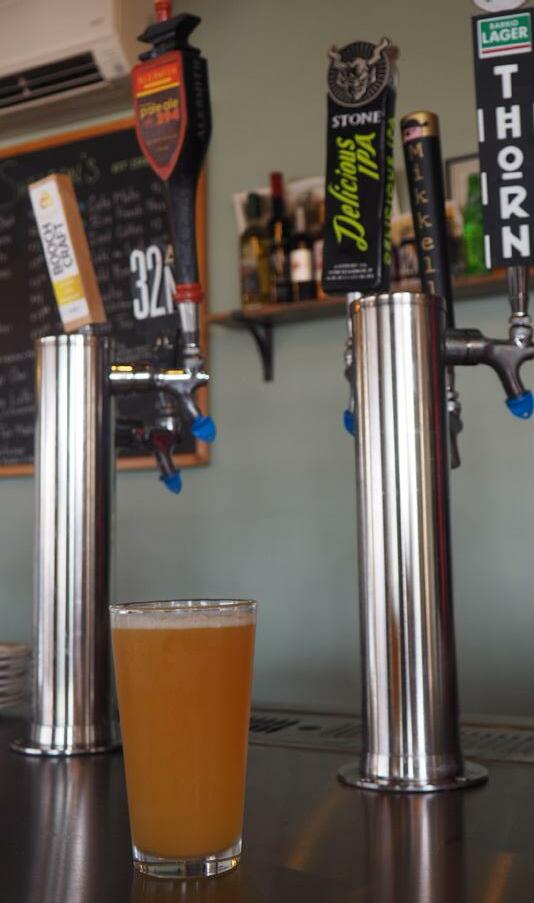
All of that exercise convinced me I deserved a beer, so I trekked back down to La Mesa Boulevard and headed to Sheldon’s Service Station, an appropriately named restaurant in a former gas and service station. The tap list here features a rotating cast of local brews, and the food menu is geared towards breakfast and lunch dishes. I grabbed a Mikkeller hazy IPA and an order of avocado toast, took a seat on the outdoor shaded patio, and watched the lunch crowd materialize as foot traffic began to pick up across La Mesa Boulevard.
After lunch I headed to Vine Ripe, a market that specializes in European and Middle Eastern grocery and deli items alongside organic produce and other foodstuffs. Of particular interest are their bulk and spice sections, which offer a range of products not easily found elsewhere in San Diego. The spice aisle has just about
everything a cook could ever want: Pink peppercorns, za’atar, sumac, anise, and five-spice powder are just a sampling from an impressive selection. Beans, grains, lentils, and rice are also available in bulk. Locals love Vine Ripe’s deli section—notably their variety of feta cheeses and sandwiches, like the popular Tri-Tip Fecta, a pepper medley tri-tip hoagie with caramelized red onions, mushrooms, wasabi-cilantro mayonnaise, and fresh provolone cheese on a crusty roll. I grabbed one for the road.
La Mesa is the latest community to play host to San Diego’s craft beer obsession, where new tasting rooms seem to open every few months. Helix Brewing Co. features 12 rotating taps, ranging from double IPA hop bombs to chocolatey stouts to Belgian-style ales. The afternoon heat inspired me to order the Acid Drop, a tart but refreshing Bavarian-style weizen with Goldings hops and German yeast that clocks in at a low 3.7% ABV—perfect for the blazing sun. While there, I dug into my sandwich from Vine Ripe; the red onions cut the fat from the mayo, cheese, and tri-tip, and the heat from the wasabi rounded everything out. The light beer was the perfect accompaniment.
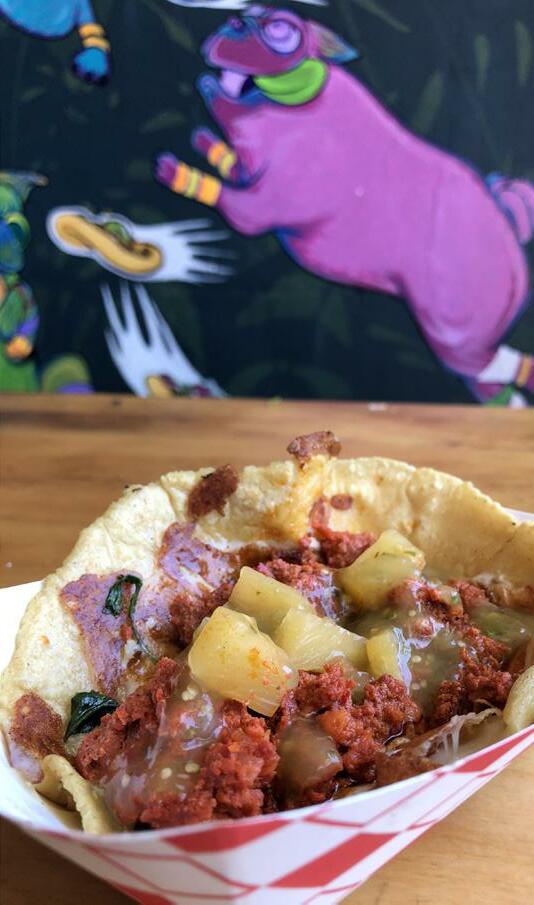
After drinking and snacking some more, I decided to walk it off by heading to Amethyst Moon and perusing the boutique’s offerings; bright purple and opaque amethysts and other stones, metaphysical books, incense, massage and Reiki candles, essential oils, and jewelry are all on display in the well-appointed gift shop.

I found that when it comes to happy hour, La Mesa Wineworks can’t be beat. It’s a cooperative tasting room operated by two separate San Diego County wineries, San Pasqual Winery and Wyatt Oaks Winery. Though some of the wines offered were made with grapes sourced from elsewhere in California, I decided to stick to San Diego County fruit. I opted for a peppery 2013 Zinfandel from Wyatt Oaks because I appreciate opportunities to taste wines that omit sulfites (preservatives) from the winemaking process.
For dinner, I decided to check out one of my favorite North Park mainstays: City Tacos. Their La Mesa outpost has the same Californiameets-Mexico menu but is more friendly to dining in. With ample seating inside and a sprawling, comfortable patio out back, it’s the ideal spot to while away an evening while eating original tacos and sipping
on Mexican brews or agua frescas. My favorite is the chorizo asado taco with melted Oaxaca cheese, so I ordered up one of those as well as the Especial with shrimp, octopus, squid, Oaxaca cheese, panko-fried snow crab, cilantro, and serrano chiles on a flour tortilla.
With its bustling residential community and hearty dose of local pride, La Mesa is an example of San Diego County at its best. La Mesans are embracing the way their enclave is growing and changing and are dedicated to supporting local businesses and restaurants (like the highly anticipated fourth location for Surfrider Pizza). This is no small feat in a world where big-box stores and chain restaurants are proliferating at a fast clip. Another bonus is that the

downtown village area is exceptionally walkable and has multiple transit stops for both the MTS bus and trolley. There are plenty of excuses to explore the Village on foot during the farmers’ market (3–7pm) on a Friday afternoon, during the summer car shows on a Thursday evening, or during the La Mesa Oktoberfest—one of the best in the county—which will be celebrating its 45th anniversary this year from September 28–30.
Looking for a delicious day steeped in all things local? Turns out one needn’t look much further than just east down the 8. D
Jackie Bryant is a freelance writer who lives in Ocean Beach. More of her work can be found at jackiebryantwriting.com.
Editor’s Note: This is the final story in a three-part series that takes you inside the inspiring world of San Diego’s food-based nonprofits. You can find the first two stories covering social enterprise and food access organizations in the 2018 January–February and March–April issues and online at ediblesandiego.com. While we were unable to highlight every organization worthy of mention in this series, our website also features a living directory of local food-based nonprofits.
As Wendell Berry pointed out decades ago, “To be interested in food but not in food production is clearly absurd.” Because food production is a community issue, building a strong food system requires community participation. Local nonprofits Olivewood Gardens, Humane Smarts, and ProduceGood know this—these three organizations built engagement into their mission. As a result, they’ve created ambassadors who share their knowledge with friends, families, and neighbors.
“We’re very much community-driven,” says Claire Groebner, Olivewood Gardens’ development director. Olivewood Gardens serves the National City and South Bay communities by empowering students and families from diverse backgrounds to be healthy and active citizens.
“We do our best to create programming based on what our community’s needs are,” Groebner says. “[Residents] don’t have a lot of access to education around health, nutrition, and the environment—and they want it.” In response, Olivewood offers organic gardening, environmental stewardship, and nutrition education initiatives.
Perhaps the nonprofit’s most inspiring example of working hand in hand with the community is Cooking for Salud. This bilingual English and Spanish program equips parents (mostly Latina mothers with chronic health issues in the family) with the skills and knowledge needed to turn their kitchens into healthy food zones. Through training from professional chefs, doctors, and program alumni, participants learn how to bring nutrition back home.
Upon graduating, each Cooking for Salud participant is crowned with the title kitchenista. These kitchenistas become advocates for health in their communities by rallying friends and family to eat well and by conducting presentations in schools. National City and South Bay are now home to 174 kitchenistas—a substantial force for health in local neighborhoods. Groebner says that this kind of grassroots change is exactly what Cooking for Salud hopes to spark: “We want to empower leaders in the community and lift them up to become advocates for change.”
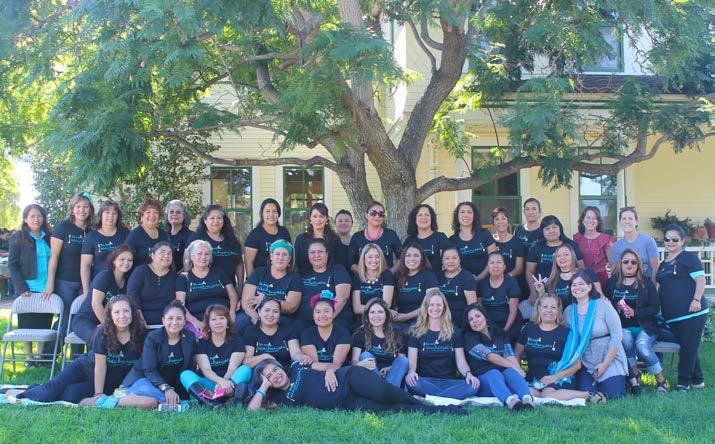
In the heart of downtown San Diego, an urban farm occupying 16,000 square feet connects students and adults over a shared interest: growing nourishing food. Run by
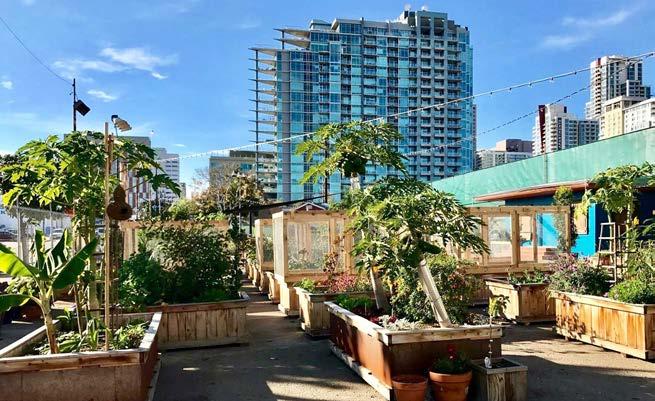
the nonprofit Humane Smarts, SMARTS Farm offers a place for collaborative community gardening, where residents connect to the land and their food.
Through relationships with schools and neighborhood residents, SMARTS Farm invites San Diego’s urban population to learn about food through hands-on experiences. Thousands of kids have visited the farm to harvest their own salads, learn about soil amending, and compare GMO and non-GMO seeds. Founder Susan Madden Lankford says that the kids carry this knowledge home with them: “Without being told, they experience [gardening] first hand and they pass it along.”
While kids get their hands dirty, downtown residents work alongside them in raised garden beds. SMARTS Farm leases garden boxes to neighbors who live in high-rise apartments that might lack outdoor space suitable for growing. For a small fee, residents receive a cedar box, soil, water, sunlight, and the freedom to grow organic crops ranging from avocado to mango to passion fruit. “One resident even planted cotton,” Lankford says. “Now that resident is teaching the kids about growing cotton. It’s a total thrill to see this type of community interaction take place.”
“At the farm [children and adults] blend naturally,” Lankford says. By inviting diverse residents to engage with each other, the SMARTS Farm plants seeds of collaboration in its garden and beyond.
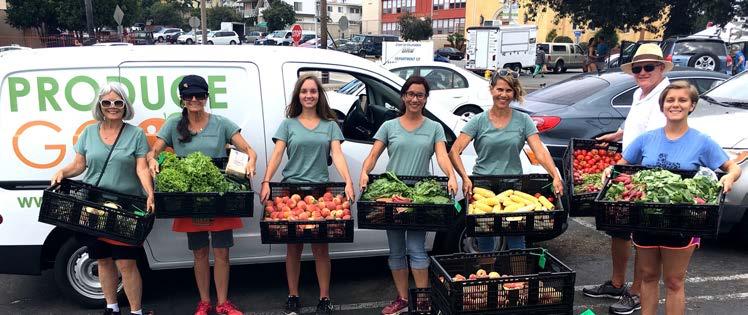
“Being a nonprofit with a paid staff of 2.5, we absolutely need citizen engagement to power our programs,” says Nita Kurmins Gilson. With partners Jerilyn and Alexandra White, Gilson co-founded ProduceGood, a gleaning organization that combats food waste and hunger by harvesting San Diego’s extra bounty and delivering it to those in need. Just as impressive as the 425 tons of edible food diverted from landfills is ProduceGood’s volunteer force.
Dozens of dedicated gleaners join ProduceGood every week to pick fruit in North County residential orchards. Another group recovers and transports rescued produce from farmers’ markets to feeding agencies, while others glean veggies from Coastal Roots Farm. With a database of over 750 local volunteers, the organization has tapped into a powerful form of community engagement.
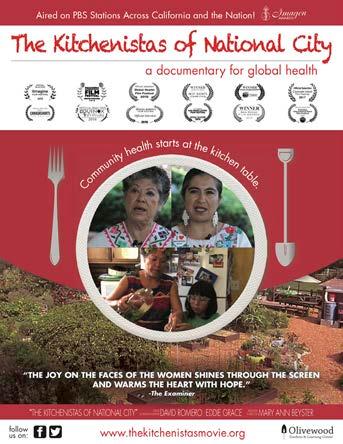
“Many of [our volunteers] are ambassadors of our program, spreading our gospel of
gleaning to any interested parties,” Gilson says. “Once they pick that first orange, upcycle that first box of zucchini, meet the farmers that grow their food, they are energized.” After all, unlike reading statistics, actually picking up boxes of unsold fruit at a market makes food waste real.
“Food waste and food insecurity know no age limits, and both of these issues affect all of our community,” says Gilson. “Understanding that these are issues they can actively help solve empowers our volunteers, from age two to 82.”
While their programs are diverse, Olivewood Gardens, SMARTS Farm, and ProduceGood share a spirit of empowerment. The collaborative approach equips community ambassadors to plant seeds of health in their own kitchens, classrooms, and neighborhoods. Because a healthy food system begins with the people who grow and eat the food, each one of us has a role to play.
Want to donate or volunteer to help build a healthier local food system? Visit olivewoodgardens.org, humanesmarts.org, and producegood.org for more. D
Annelise Jolley is a San Diego-based writer and editor interested in stories about food, travel, and community development. She earned her MFA in creative nonfiction writing and her work has appeared in Sojourners and Civil Eats, among others. Follow her on Twitter @annelisejolley or say hello at annelisejolley.com.
Katie Stokes led two educational nonprofits in Escondido for nearly 20 years and has served as a volunteer on several boards of directors. Her MA in geography and her passion for travel, culture, and family inform and inspire her current work as publisher of Edible San Diego
With the opening of Grand Ole BBQ Flinn Springs, you might find yourself out in El Cajon more than ever before. (At least we will.) And if you’re looking for a good excuse to walk off some of that BBQ, you’ll find the Water Conservation Garden on six acres near the Heritage of the Americas Museum and Cuyamaca College. The nonprofit garden demonstrates how attractive and purposeful waterwise landscaping can be when applied to native landscapes and vegetable gardens. Admission to the garden is free on the first Saturday of every month from 10am with docent-led or self-guided tours. Additional events on the calendar for September and October include morning yoga on the third Monday morning of every month and the popular Sips and Succulents tour on September 26. (Who doesn’t love wine and succulents?) The space is also available to host corporate events, personal parties, and wedding ceremonies and receptions.
You can support the garden and receive discounts on classes and special events by becoming a member.
thegarden.org
Welcome the season of hard squashes, U-pick apples in Julian, and pumpkin everything. According to the San Diego County Farm Bureau Harvest Calendar, Asian pears should be making appearances in October. Figs and passionfruit are sure to be dripping off their branches and vines, and the region’s dragon fruit should be coming into their prime.
For a unique farm-to-table experience at The Lodge at Torrey Pines, try this intimate communal dinner prepared by executive chef Jeff Jackson and chef de cuisine Kelli Crosson. Here, you’ll be presented with tempting dishes expertly paired with delicious wines, all while enjoying the view from the terrace overlooking the 18th hole of the Torrey Pines Golf Course.
lodgetorreypines.com
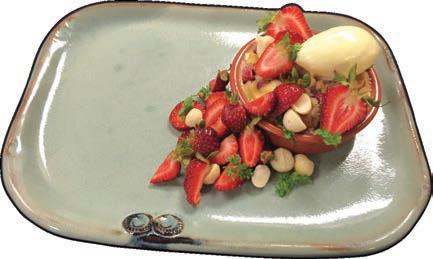
Learn to craft Italian cuisine with chefs Accursio and Brian during this immersive, hands-on experience in Solare’s commercial kitchen. Italian-style coffee and pastries are served, along with Italian wine for students interested in cooking with wine. Classes are $75 and limited to 10 participants every other Saturday. solarelounge.com
Ecolife’s
Wear all white attire to enjoy an open bar and sample creative eats prepared by chefs Ricardo Cervantes, Kelli Crosson, Saransh Oberoi, Jason Knibb, Phillip Esteban, and Jon Bautista at this VIP fundraising event. Live entertainment will be provided by NuVintage, and silent and live auctions will raise funds to improve lives, save endangered species, and protect natural resources. The 15th annual event will be held on September 22 from 6–10pm at Lot 8 in Mission Valley. ecolifeconservation.org
Celebrate our region’s outstanding produce, seafoods, and meats with expertly prepared dishes by dedicated chefs at San Diego’s premiere farm-to-fork dining destinations September 9–16. Participating locations are verified to source ingredients from local farmers, fishermen, and ranchers so that local food dollars stay local. Restaurants will feature prix fixe menus and specials. Look for special events to kick off on Wednesday, September 5 at 8:30am and Shop with the Chefs at Little Italy Wednesday Market. farmtoforksd.com
Eat, laugh, and share delicious dishes at over 200 restaurants September 23–30. Threecourse prix fixe dinners for $20, $30, $40, and $50, and two-course prix fixe lunches for $10, $15, or $20. No tickets needed, but reservations are recommended! sandiegorestaurantweek.com
On October 14 celebrate sustainable food with 30 celebrity chefs (including Katsuji Tanabi from “Top Chef” and James Beard nominee Javier Plascencia) and mixologists competing with dishes and drinks made from food that would otherwise be discarded. wastedcelebration.com
courtesy of
Photo
Escondido—Welk Resort # 8860 Lawrence Welk Dr. 3–7pm, year-round 760-651-3630
Seeds @ City Urban Farm 16th & C Sts., San Diego City College 10:30am–12:30pm Sept–June cityfarm@sdccd.edu
Coronado 1st St. & B Ave., Ferry Landing 2:30–6pm 760-741-3763
Escondido * Heritage Garden Park Juniper btwn Grand & Valley Pkwy. 2:30–6pm 760-480-4101
Mira Mesa * 10510 Reagan Rd. 2:30–7pm (3–6pm, fall–winter) 858-272-7054
Otay Ranch—Chula Vista 2015 Birch Rd. and Eastlake Blvd. 4–8pm (3–7pm, winter) 619-279-0032
Pacific Beach Tuesday *# Bayard & Garnet 2–7:30pm (2–7pm, fall-winter) 619-233-3901
UCSD Town Square UCSD Campus, Town Square 10am–2pm, Sept–June 858-534-4248
Vail Headquarters * 32115 Temecula Pkwy. 9am–1pm 760-728-7343
Grantville
4647 Zion Ave. Noon–4pm 619-550-7180
Little Italy Wednesday NEW! *# 555 W. Date St. 9am–1pm 619-233-5009
Ocean Beach 4900 block of Newport Ave. 4–7pm (4–8pm summer) 619-279-0032
People’s Produce
Night Market *#
1655 Euclid Ave. 5–8pm 619-813-9148
Santee *# Carlton Hills Blvd. & Mast Blvd. 3–7pm (2:30–6:30pm winter) 619-449-8427
State Street in Carlsbad Village State St. & Carlsbad Village Dr. 3–7pm (3–6pm, fall–winter) 858-272-7054
Temecula - Promenade * 40820 Winchester Rd. by Macy’s 9am–1pm 760-728-7343
Lemon Grove NEW! 2885 Lemon Grove Ave. 3–7pm 619-813-9148
Linda Vista *# 6900 Linda Vista Rd. 3–7pm (2–6pm, winter) 760-504-4363
North Park Thursday *# North Park Way & 30th St. 3–7:30pm, year-round 619-550-7180
Oceanside Morning * Pier View Way & Coast Hwy. 101 9am–1pm 760-791-3241
Rancho Bernardo 16535 Via Esprillo btwn Via Fontero & Via del Campo 11am–2pm 619-279-0032
SDSU Campanile Walkway btwn Hepner Hall & Love Library 10am–3pm, Sept–June www.clube3.org
Sleeves Up Horton Plaza 199 Horton Plaza 10am–2pm 619-481-4959
Valley Center 28246 Lilac Rd. 4–8pm vccountryfarmersmarket@gmail.com
Borrego Springs Christmas Circle Comm. Park 7am–noon, Oct–May 760-767-5555
Horton Plaza # 225 Broadway Circle 11am–2pm 619-550-7180
Imperial Beach *# Seacoast Dr. at Pier Plaza Oct to Mar, 2–7pm; Apr to Sept, 2–7:30pm info@imperialbeachfarmersmarket.org
La Mesa Village * La Mesa Blvd. btwn Palm Ave. & Allison St. 3–7pm 619-550-7180
Rancho Bernardo Winery 13330 Paseo del Verano Norte 9am–1pm 760-500-1709
City Heights *#! Wightman St. btwn Fairmount & 43rd St. 9am–1pm 760-504-4363
Del Mar 1050 Camino Del Mar 1–4pm 858-465-0013
Little Italy Mercato *# 555 W. Date St. 8am–2pm 619-233-3901
Pacific Beach 4150 Mission Blvd. 8am–noon 760-741-3763
Poway * Old Poway Park 14134 Midland Rd. at Temple 8am–1pm 619-249-9395
Rancho Penasquitos YMCA 9400 Fairgrove Ln. & Salmon River Rd. 9am–1pm 858-484-8788
Scripps Ranch 10380 Spring Canyon Rd. & Scripps Poway Pkwy.
10am–2:30pm 858-586-7933
Temecula—Old Town * Sixth & Front St. 8am–12:30pm 760-728-7343
Vista *# 325 Melrose Dr. South of Hwy 78 8am–1pm 760-945-7425
Allied Gardens Sunday Lewis Middle School 5170 Greenbrier Ave. 10am–2pm 858-568-6291, 619-865-6574
Fallbrook—Valley Fort 3757 South Mission Rd. 10am–3pm 951-695-0045
Hillcrest * 3960 Normal & Lincoln Sts. 9am–2pm 619-237-1632
La Jolla Open Aire Girard Ave. & Genter 9am–1:30pm 858-454-1699
Leucadia * 185 Union St. & Vulcan St. 10am–2pm 858-272-7054
Murrieta * Village Walk Plaza I-15, exit west on Calif. Oaks/Kalmia 9am–1pm 760-728-7343
North San Diego / Sikes Adobe # 12655 Sunset Dr., Escondido 10:30am–3:30pm 858-735-5311
Rancho Santa Fe Del Rayo Village 16079 San Dieguito Rd. 9:30am–2pm 619-743-4263
Santa Ysabel Hwy 78 and 79 21887 Washington St. Noon–4pm 760-782-9202
Solana Beach 410–444 South Cedros Ave. Noon–4pm 858-755-0444
* Market vendors accept WIC (Women, Infants, Children Farmers’ Market checks)
# Market vendors accept EBT (Electronic Benefit Transfer)
! Currently only City Heights accepts WIC Farmers’ Market Checks and the WIC Fruit and Vegetable Checks.
All San Diego County markets listed except, SDSU, and Seeds @ City are certified by the County Agricultural Commissioner. Visit ediblesandiego. com and click on “Farmers’ Markets” for more
complete information and links to farmers’ market websites.
This list is updated each issue with the most current information provided by market managers.
Check out Edible San Diego’s new advertising section featuring eateries from across the county. These restaurants are either locally owned, passionate about local sourcing, or both. Enjoy a delicious meal and make sure to tell our advertisers that Edible San Diego sent you!
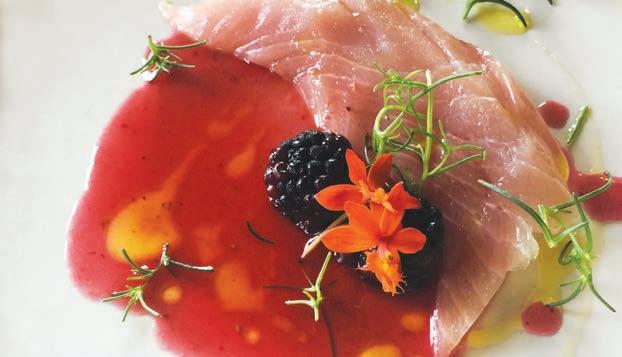
A.R. Valentien

11480 North Torrey Pines Rd., La Jolla 858-453-4420 • lodgetorreypines.com/ar-valentien

The Torrey Pines Lodge’s signature restaurant, A.R. Valentien, highlights regional San Diego cuisine served in an elegant, timbered indooroutdoor dining room overlooking the 18th hole of Torrey Pines Golf Course. Executive chef Jeff Jackson sources only the best local provisions, and the menu changes frequently based on seasonal fare available. The restaurant takes its name from a talented early 20th-century California artist whose works are exhibited throughout the restaurant.

EscoGelato
122 South Kalmia St., Escondido 760-745-6500 • escogelato.com
Located in the heart of Escondido, EscoGelato is made fresh daily using the highest quality ingredients and fresh fruit sourced from local farmers. The result is a luscious, super-creamy gelato that’s full of flavor. You will taste the difference. In addition to the main event, enjoy a nice selection of paninis, soups, salads, coffee, and tea.
LuckyBolt

10920 Roselle St. #104, San Diego 619-940-7191 • luckybolt.com
LuckyBolt is focused on making it easy and affordable to maintain a healthy diet and support local, sustainable farms by providing daily food delivery to the workplace. They recently opened their flagship Kitchen & Takeaway, just across from the Sorrento Valley train station. They offer a variety of delicious breakfast and lunch options made from scratch daily, so feel free to become a regular. Tip: The breakfast sandwich is life-changing.
Masters Kitchen and Cocktail


208 S. Coast Highway, Oceanside 760-231-6278 • mastersoceanside.com


Masters, once a well remembered drag car shop, is now a revamped industrial space with authentic character and creative food. The restaurant offers an inviting dining experience and a lovely escape from the nearby beach, with a menu featuring such crowd favorites as the
Masters burger, truffle fries, and carne adovada tacos. A separate bar with communal seating serves traditional craft cocktails, that sip and smell of the 1920’s, taking you back to its historic past.

The Whet Noodle
1813 S. Coast Highway, Oceanside 760-453-2738 • thewhetnoodle.com
This is not your traditional ramen house. Whet Noodle is a Japanese izakaya (pub), with a commitment to quality local products, sustainable seafood, and zero waste. The menu features a variety of hot and cold shareable appetizers, like scallops, calamari, and fried sweetbread nuggets. The ramen offering consists of a hot and sour miso broth made with vegetable stock that’s vegan and gluten-free or a duck shoyu stock, made with slow-smoked duck meat. The noodles are made to order and are “crispy on the outside and gooey on the inside.”
Wrench and Rodent Seabasstropub
1815 S. Coast Highway, Oceanside 760-271-0531 • seabasstropub.com
The W&R team strives to provide a unique dining experience that is casual and accessible, while also exciting and constantly evolving. They take pride in offering locally and responsibly sourced ingredients, with special care taken to minimize waste. Executive chef Davin Waite conjures up a menu relying on the highest quality, chef-selected fish and produce. The menu offers a variety of options ranging from rolls and nigiri to elaborate sashimi plates and unconventional omakase. Very vegan friendly.
M ISSION BEACH
Juice Wave
3733 Mission Blvd., Mission Beach 858-488-0800 • juicewavesd.com
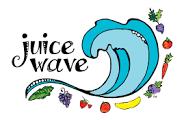
What began as San Diego’s first organic juice truck now has two happy homes in Miramar and Mission Beach. Still, their commitment rings true: “Refresh and nourish the soul by using the best quality farm-fresh ingredients from local farms that reflect the radiant growing season in Southern California.” Check out their creatively named cleanses like Lettuce Love, Turnip The Beet and Kalefornia.
Oceana Coastal Kitchen 3999 Mission Blvd., San Diego 858-539-8635 catamaranresort.com/diningentertainment/oceana-san-diego-restaurant
Oceana Coastal Kitchen features chef-driven California cuisine and a modern, oceaninspired design. Oceana offers bay-front dining at an iconic Pacific Beach hideaway. Executive chef Steven Riemer’s playful interpretations of classic dishes highlights the purity and flavors of California local produce and a commitment to sustainable ingredients. A cold bar with sushi options, small bites, and main dishes includes the freshest seafood available from the coast of Baja and the Pacific.



POINT LOMA
Cupcakes Squared 3772 Voltaire St., San Diego 619-226-3485 cupcakessquared.com
Cupcakes Squared is celebrating its ninth year in Point Loma as San Diego’s first cupcake bakery. Each day, they proudly bake from scratch a selection of seasonal cupcakes, cookies, squares and other desserts, using the finest ingredients. They also have a line of delicious, grab-and-go savory items like tamales, quiches, and shepherd’s pie with vegetarian, gluten-free, and vegan options.
Mitch’s Seafood 1403 Scott St., San Diego 619-222-8787 mitchsseafood.com
Established in 2008 by three families with a long history of fishing in the Point Loma, Mitch’s specializes in fresh seafood from the waters off San Diego. Located directly on the city’s working waterfront with a view of the fishing fleet, the focus is on simply prepared, California style seafood, accompanied by a nice selection of craft beer and wine from San Diego and California.
Royale!
4204 Voltaire St., San Diego 619-431-5653 royalesd.com
This family-owned and operated gem serves up the finest burgers and farmto-shaker cocktails. They source many of the fruits and veggies from their own family farm, Nopalito. The beef is organic and grass-fed and the bread is baked fresh daily, so expect most things to be made

in-house, aside from the American cheese and ketchup. Cool place for happy hour, late-night bites, and Sunday brunch.
Solare
2820 Roosevelt Rd., San Diego 619-270-9670 • solarelounge.com
Solare is an authentic Italian restaurant with a special focus on southern Italy and Sicily featuring a menu made with fresh ingredients selected daily. Blending modern and traditional tastes, the results are light and healthy dishes, brimming with natural flavors. Complement your meal with one of 2,000 bottles of wine from the cellar or 30 wines by the glass. Solare is commited to serving the cuisine of today, created with all the love and attention to detail from generations past.


Biga 950 6th Ave., Suite C, San Diego 619-794-0444 • bigasandiego.com

A community hub where you can get honest food in a warm, welcoming setting. Named after an age-old fermentation process used for Italian breads and pizza dough, Biga is a celebration of handcrafted Italian cuisine.

Biga’s constantly evolving menu is created with seasonal, local ingredients, combining high-quality imported Italian goods with items made by hand to make incredibly delicious food. Combine highquality Italian imported goods with items made by hand, and that equals delicious food. Veganfriendly and gluten-free options.
Herb & Wood 2210 Kettner Blvd., San Diego 619-955-8495 • herbandwood.com
Chef Brian Malarkey and his team present a unique dining experience at their flagship venue, located in the noteworthy gastronomic neighborhood of San Diego’s Little Italy. The team’s decade of experience working side by side has created a timeless, soughtafter dining escape that incites long dinners, conversation, and culinary delight.
Juniper & Ivy 2228 Kettner Blvd., San Diego 619-269-9036 • juniperandivy.com
Located in Little Italy, Juniper & Ivy offers refined American cuisine with unique iterations of the classics. Led by chef-partner Richard Blais, the whimsical menu features a variety of options, including snacks, crudo, pastas, toasts, small plates and more. Always in a constant state of change, the menu depends on the freshest, seasonal ingredients provided by local purveyors.
Kettner Exchange 2001 Kettner Blvd., San Diego 619-255-2001 • kettnerexchange.com
This restaurant space boasts two levels of indoor and outdoor drinking and dining, filled with subtle nods to the city’s great bay and nautical
history. Corporate executive chef Brian Redzikowski’s rotating menu features innovative dishes from Tender Belly Farms suckling pig larb to hamachi ceviche to foie gras French toast and grilled quail char sui. The space’s main attraction is an open rooftop patio, where award-winning bartender and beverage director Steven Tuttle leads the restaurant’s thoughtful and dynamic cocktail program.

TOWN
Tiger! Tiger! Tavern 3025 El Cajon Blvd., San Diego 619-487-0401 • tigertigertavern.com
The atmosphere at Tiger! Tiger! is casual and cool with an urban vibe.
From its signature wood-fired oven in the dining room comes roasted oysters and well-made sandwiches. The seating is communal and the beer list is lengthy. A chalkboard features the wide variety of brews, complete with craft descriptions and alcohol content. The 60oz. pitcher for $16 is a major deal.
Starlite 3175 India St., San Diego 619-358-9766 • starlitesandiego.com
Starlite offers housemade cuisine made with seasonal Southern California produce. The menu changes frequently to accommodate the seasonality of local products and features dishes ranging from comforting mac and cheese to the creative Buffalo fried cauliflower. Their mission is and always has been to use as much local and/or organic fruits and veggies as possible. This means 90% of the produce served comes from your neighbors.
Panama 66
The San Diego Museum of Art 1450 El Prado, San Diego 619-696-1966 • panama66.com
Located in the Sculpture Court at the San Diego Museum of Art in Balboa Park, Panama 66 is a counter service restaurant with quality sourced ingredients. The menu features a satisfying selection of soups, salads, sandwiches, and shareables, with a full bar and a praiseworthy San Diego draft beer selection. Check out Art After Hours at SDMA, Fridays 5–8pm, and for only $5 after 5pm on Fridays you can enjoy live music and experience special exhibitions and the museum’s 20 galleries.

Ceviche House 2415 San Diego Ave., San Diego 619-795-2438 • cevichehousesd.com
This go-to spot for seafood delivers upscale ceviche creations from executive chef Juan Carlos, crafted with locally sourced produce and fish. A menu favorite, the La Paz ceviche, showcases bigeye tuna finished with a habanero-lime salsa. The tuna is caught by San Diego fishermen and the freshness is evident in the flavor. Beyond the ceviche offerings, look for madeto-order guac, handmade tortillas, and the daily fresh catch, plus a solid selection of beer and wine.
Cardamom Cafe and Bakery 2977 Upas St., San Diego 619-546-5609 • cardamomsandiego.com
A neighborhood bakery and breakfast spot with a long list of classic breakfast dishes ranging from pancakes and pastries to omelets and Benedicts, including a few locally caught seafood items. A similar approach carries through to lunch, which features a variety of sandwiches served on fresh-baked bread.

Blind Lady Ale House 3416 Adams Ave., San Diego 619-255-2491 • blindladyalehouse.com
Nothing goes together better than a pint and a slice. Blind Lady excels at both. The pizza offerings range from the classic margherita to creative options like the house chorizo with poblano chiles, fontina, epazote, and cotija. While the pizza is the headliner, expect a variety of brewpub snacks like Belgian frites and spicy beer nuts.
Bivouac CiderWorks 3986 30th St., San Diego 619-725-0844 • bivouaccider.com
As a center for experimentation, comradery, and weirdness, Bivouac CiderWorks is a welcome home for active, creative, and outdoorsy cider and food enthusiasts alike. Their goal is to inspire curiosity and foster a passion for what craft cider brings to the table. The space is an outdoor-inspired tasting room, right in the heart of North Park, with a full menu of food options. Don’t miss the Impossible Burger, awardwinning tuna poke, and vegan jackfruit sliders.
Garden Kitchen 4204 Rolando Blvd., San Diego 619-431-5755 • gardenkitchensd.com
Located in the San Diego neighborhood of Rolando, this healthy farm-to-table restaurant satisfies all tastes, from vegan to vegetarian to meat lovers. All meals are served outside on a lovely covered patio with a casual, dog-friendly atmosphere. Their menu changes regularly because each day it’s crafted from scratch using local, farm-fresh ingredients. Their cooking style reflects a love of all flavors, colors, cuisines, and cultures.

Terra American Bistro 7091 El Cajon Blvd., San Diego 619-293-7088 • terrasd.com
Terra serves New American cuisine with an emphasis on ingredients and preparation styles from North, South, and Central America. The atmosphere is comfortable, with exposed brick, wood beams, and a captivating chandelier over a communal farm table. The restaurant’s focus on local, sustainable, and organic extends to the bar, which features seasonal fruit and herb-infused vodkas made in-house.
COASTAL ROOTS FARM STAND
Cultivating healthy communities by integrating sustainable agriculture, food justice, and ancient Jewish wisdom. Farm Stand open Sun, 10am–3pm; Thu, 2–6pm. 441 Saxony Rd., Encinitas, 92024 • hello@coastalrootsfarm 760-479-6505 • CoastalRootsFarm.org

Veteran owned and operated farm in National City producing organically grown, heirloom fruits, vegetables, and herbs. 1430 E 24th St., National City, 91950 • hello@dickinson.farm 858-848-6914 • Dickinson.farm
ESCONDIDO CERTIFIED FARMERS’ MARKET
Find everything you need here, including meat. Sponsored by the Escondido Arts Partnership. Tue, 2:30–6pm year-round on Grand Ave. between Juniper and Kalmia. 760-480-4101 • EscondidoArts.org
Delivers organic produce to your door from family farms in Capay and San Diego and Imperial Counties, weekly, biweekly, or every third or fourth week. No seasonal commitment required. Sign up with code “eathealthy18.” contactus@farmfreshtoyou.com • 800796-6009 • FarmFreshToYou.com
Local, seasonal, and exceptionally fresh produce (and other foods). All produce grown locally, ensuring it is fresh and delicious. Open daily 10am–6pm. 2115 Miller Ave. Citracado Pkwy. at Interstate 15, Exit 29, Escondido • 760-738-9014 TheFarmStandWest.com
LA JOLLA OPEN AIRE MARKET
Sun, 9am–1pm at La Jolla Elementary School on Girard. A great community success story! All proceeds benefit the school. 7335 Girard Ave. at Genter. • 858-454-1699 LaJollaMarket.com
Sun, 10am–2pm at Paul Ecke Central School, 185 Union St. off Vulcan in Leucadia. A big weekend farmers’ market with just about everything, including knife-sharpening. 858-272-7054• Leucadia101.com
Lucky Bolt makes it easy and affordable to eat well while you’re busy at work. Order by 10:30am and lunch will arrive between 11:30am and 12:30pm. talk@luckybolt.com • LuckyBolt.com

Sun, 10:30am–3:30pm, year-round. Fresh produce, pastured eggs, raw honey, plants, ready-to-eat and take-home foods from San Diego County producers. EBT/credit cards accepted. I-15 at Via Rancho Pkwy., Escondido • 858-735-5311 NSDCFM.com
OCEANSIDE MORNING FARMERS’ MARKET
9am–1pm every Thu, rain or shine, at 300 North Coast Hwy. Certified fresh, locally grown fruits, veggies, and flowers, hot food, baked goods, and crafts. • outbackfarm@sbcglobal.net 619-2499395 • MainStreetOceanside.com
Local honey production from hives on small family farms and not-so-ordinary, locally grown produce and plants from a Rancho Penasquitos family farm. Producer of PQ Backyard Honey. Find RFB in the Certified Producers sections of select local farmers’ markets. • RFBFamilyFarm.com
Robust farmers’ markets with great selections at Pacific Beach on Bayard btwn Grand & Garnet (Tue, 2–7pm); Little Italy Wednesday, Date St. (Wed, 9am–1pm); and Little Italy Mercato, Cedar St. (Sat, 8am–2pm). All accept EBT. PB and NP also accept WIC. • 619-233-3901 SanDiegoMarkets.com
STATE ST. FARMERS’ MARKET IN CARLSBAD VILLAGE
Convenient midweek market. Wed, 3–6pm in fall/winter, 3–7pm in spring/summer. Over 50 vendors in Carlsbad Village east of the railroad tracks. ronlachance@gsws.net 858-272-7054 CarlsbadVillage.com

Enjoy market-driven, seasonal cuisine and experience the art of fine dining in an elegant timbered room overlooking the 18th hole of the Torrey Pines Golf Course. For a really special experience, reserve a seat at the Artisan Table on Thursday nights. 11480 N. Torrey Pines Rd. 858-453-4420 • LodgeTorreyPines.com
Brian Malarkey created one of San Diego’s most stylish, sophisticated, and highly praised restaurants. Check out the accolade page on the website. 2210 Kettner Blvd. in Little Italy. 619-955-8495 • HerbAndWood.com
Casual waterfront dining in the historic fishing neighborhood of Point Loma, serving locally caught seafood with a view of the bay
and the San Diego sportfishing fleet. 1403 Scott St., San Diego 619-222-8787 • MitchsSeafood.com
Local produce, fresh-made pasta, sustainably caught fish, hormone-free meat, exceptional wines, and craft cocktails. Tue–Sun happy hour, Tue wine specials. 2820 Roosevelt Rd., Liberty Station, Point Loma • 619-270-9670 • SolareLounge.com
DEANNA’S
Committed to creating the very best gluten-free and allergen-free breads and pastries, using only the finest natural ingredients. 2250 S. Escondido Blvd. Suite 110, Escondido, 92025 • 760-432-6100 info@deannasgf.com DeannasGF.com
Committed to providing people everywhere with the best quality foods available, Bob’s Red Mill has a complete line of nutritional whole grain products, including gluten-free oatmeal in a cup, muesli, ancient grains (sorghum, millet, and farro), and glutenfree flour. • BobsRedMill.com

EscoGelato’s luscious, super-creamy gelato is full of intense flavor and made fresh daily with the highest quality ingredients including fruit sourced from local farmers at the Escondido Farmers’ Market. 122 South Kalmia, Escondido, 92025 • 760-745-6500 • EscoGelato.com
Fresh juices, smoothies, shots and Acai bowls served from a food truck modified to run on propane and a store at 3733 Mission Blvd. San Diego 92109, and 8680 Miralani Dr. Ste. 135 San Diego 92126. Ingredients sourced from local farmers’ markets, and all waste is recycled. 240-246-5126 • JuiceWaveSD.com
Feed your dog food made from best quality human grade meats, organic fruit & vegetables, organic micro & macro nutrients with no fillers, additive or preservatives. Grain- and antibiotic-free and non-GMO. 845-328-0364 • UrbanWolf@MaxotaRaw.com • MaxotaRaw.com





Foodie-approved paleo desserts since 2009! These guys are serious about flavor, texture, ingredients, and all things paleo. Shipped all over the world. 100% guaranteed. 619-795-2203 • 4662 30th St., San Diego, 92116 • PaleoTreats.com
Join us in thanking these advertisers for their local and sustainable ethics by supporting them with your business.
An award-winning TV and online garden lifestyle program featuring one of the West’s leading garden experts, Nan Sterman. Viewers see local farms, residential gardens, vineyards, native habitats, green rooftops, community gardens, and nurseries. Thu, 8:30pm and Sat, 3:30pm on KPBS, and online. • AGrowingPassion.com/tv-schedule/
Dedicated to a world in which humans and nature live harmoniously using conservation as a tool. Aquaponics, fuel efficient stoves, eco kits and a lot more. Attend gala on Sept 22, 2018. 760-740-1346 • 101 N Broadway, Escondido, 92025 EcolifeConservation.org
GRANGETTO’S FARM & GARDEN SUPPLY
Organic headquarters for plant food, amendments & mulch, seed & sod, veggies & flowers, garden tools, water storage, irrigation & vineyard supplies, bird feeders & seed, pest & weed control. Articles, tips, and how-tos at Grangettos.com. Locations in Encinitas, Fallbrook, Escondido, and Valley Center.
GREEN
Family-owned since 1946. Organic and natural products for your edible garden, trees, shrubs, flowers, succulents, and everything you need for their care. Home canning supplies. 1019 San Marcos Blvd. off the 79 Fwy near Via Vera Cruz • 760-744-3822 • SuperGarden.com
SAN DIEGO SEED COMPANY
Heirloom vegetable, herb, and companion flower seeds grown sustainably and acclimated to our microclimates and soil conditions. Buy online at and at select nurseries, garden and farm supply stores. • 414-797-3726 SanDiegoSeedCompany.com
Edible gardens and fruit trees for your home and business. Complete design, installation, maintenance, and refresh services for everything from small home gardens to restaurant and corporate campus gardens. • 619-563-5771 • UrbanPlantations.com
WILD WILLOW FARM & EDUCATION CENTER
Educating the next generation of farmers, gardeners, and homesteaders. Check calendar for monthly Open House Potluck; 4–9pm. Tours, field trips, and venue rental. Visit their blog at theartofagriculture.org • wildwillowfarm@sandiegoroots.org • SanDiegoRoots.org/farm
JIMBO’S . . . NATURALLY!
Jimbo’s…Naturally! is a complete grocery store providing a full line of groceries, vitamins, health & beauty aids, hormone-free and antibiotic-free meats, deli, 100% organic salad bar, made-fromscratch bakery, and juice bar. Carmel Valley Escondido Carlsbad • 4S Ranch • Westfield Horton Plaza Downtown • Jimbos.com
Family-owned and operated natural food market with local, organic produce, raw milk, grass-fed meats, vitamins, supplements, specialty foods, and more. Open Mon–Fri, 8am–8pm, Sat-Sun, 8am–7pm. 325 6th St., Ramona • 760-787-5987 • RamonaFamilyNaturals.com
DA-LE RANCH
Sustainably raised USDA-inspected meats by the cut and CSA. Beef, pork, and lamb sides and cuts, chicken, turkey, duck, rabbit, quail, pheasant, and bison. Free-range eggs. No hormones, steroids, incremental antibiotics, GMO/soy. Find at SD, Riverside, and Orange County farmers’ markets, or at farm by appointment. • Da-Le-Ranch.com • dave@da-le-ranch.com
URBAN DWELLINGS
Dominick Fiume, real estate broker, provides exceptional customer service with specialized knowledge of urban San Diego. CalBRE No. 01017892 1228 University Ave. Ste. 200, San Diego, 92103 619-543-9500
BASTYR UNIVERSITY CALIFORNIA
California’s only fully accredited naturopathic medical school offers degrees in nutrition and culinary arts, and a Master of Science in Nutrition for Wellness. Cooking classes offered. • 4106 Sorrento Valley Blvd., San Diego, CA 92121 858-246-9700 Bastyr.edu/california.com
TREEHOUSE KITCHEN
Experience this unique cooking school located in North County to learn and have some fun! We host artisan chefs and producers who share their techniques and expertise with YOU. Check website for available hands-on workshops. 950 Saxony Rd., Encinitas, CA 92024 - 760.586.0001 - treehousekitchen.com
Bustling wholesale and retail seafood market in a working warehouse
that offers fresh, sustainably harvested seafood, much of it from local waters. Open Mon and Tue, 8am–3pm; Wed–Sun, 8am–5pm. 5202 Lovelock St., San Diego, 92110 • 619-297-9797 • CatalinaOP.com
CLAYTON VACATIONS

Experience Spotlight on Wine in the Mediterranean. Enjoy hosted dinners, wine tastings, and meet-and-greets on board the intimate Regent Seven Seas Voyager with a renowned wine expert. Contact Bitsy Clayton, cruise and vacation specialist. • 888-451-6524; 858451-6524 • bitsy@claytonvacations.com • ClaytonVacations.com
Just 30 miles from San Diego and 20 minutes from the coast, Escondido is home to beautiful wineries, craft breweries, unique arts and theater, delicious culinary experiences, and a charming and historic downtown— plus it has a lovely climate! Visit Escondido! VisitEscondido.com
CHUPAROSA VINEYARDS
100% estate-grown Zinfandel, Sangiovese, Cabernet Franc, and Albariño. Picnic on the patio overlooking the vines or warm up by the fireplace this winter inside the rustic tasting room. Open Sat and Sun 11am–5pm. 910 Gem Ln., Ramona, 92065 • 760-7880059 • ChuparosaVineyards.com
Dedicated to growing Rhone grape varietals and vinifying and blending them in traditional and innovative ways. Available for private events. Open for tastings Sat and Sun, noon–6pm. 15404 Highland Valley Rd., Escondido, 92025 • 760-432-8034 Domaine-ArtefactWine.com
A California wine estate producing Rhone and Iberian varietals high in the foothills of Palomar Mountain with a view of the ocean 30 miles to the west. Tasting room: 298 Enterprise St. Suite D, Escondido, 92029 • 888-409-8610 • info@jacksimonvineyards. com • JackSimonVineyards.com
Award-winning red wines made from 100% Ramona Valley American Vitacultural Area (AVA) grapes, mostly estate grown. Open most Sat and Sun, 11am–5pm, and by appointment. Call ahead to allow them to give you good directions and to confirm availability. 760-788-4818 • WoofNRose.com
Cold-pressed juices, smoothies & acai bowls Chef-crafted & ingredients sourced locally
Miramar: 8680 Miralani Dr.,Suite 135 Mon-Fri 8am-3pm • Sat 10am-3pm
Mission Beach: 3733 Mission Blvd. Every day 8am-3pm
ORGANIC, LOCAL, VEGETARIAN GLUTEN- & DAIRY-FREE 240.246.5126 www.JuiceWaveSD.com
Juicewavesd #JuiceWavesd #Sippinonzenandjuice
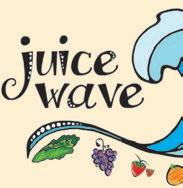







Offal: (noun) the organs or entrails of an animal used for food

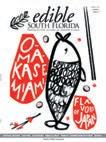
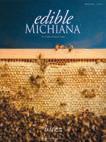


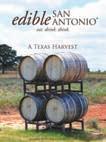
Honoring the animal whose life was sacrificed to feed yours by using all their parts might be offal, but it’s far from awful. Case in point: the deli cases at the Heart & Trotter Whole Animal Butchery. San Diego butcher and co-owner James Holstag walked us through a number of housemade items like beef bacon, sausages, and mortadella (with pistachios!) that are all prepared with 100% antibiotic- and hormone-free California-raised meats from as far north as Petaluma.




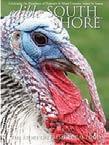


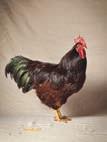
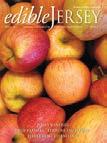
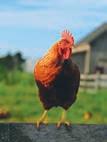
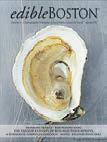
“We’re the only ones in town that actually make all of our own deli meats and charcuterie. There are two [products we carry] from Angel Salumi, which are really


great, but that’s dry-cured charcuterie. What we do is semi-cured smoked charcuterie,” Holstag says.
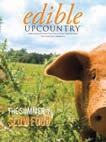
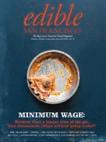



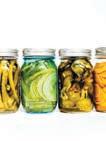


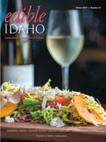


It’s the availability of various organ meats that makes Heart & Trotter stand out, especially for those looking for a dependable place for grass-fed proteins with high concentrations of vitamins and minerals. “We get everything from livers to hearts to gizzards to spleens through our ranchers, so we take those and sell them as is, which is hard to find,” explains Holstag.







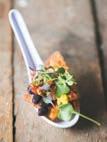

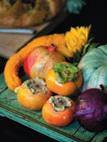









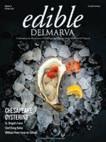

Certain dietary recommendations suggest eating organ meats for numerous health benefits, and while eating something like beef heart is off-putting to some people, Holstag
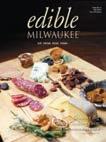
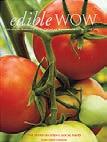







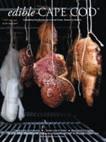
insists it’s as delicious as a prime-cut steak. “Getting over that it’s an actual heart is the hardest part, but if you’re doing a skewer with teriyaki-infused flavor, it’s absolutely phenomenal. Same with chicken hearts or any [animal] hearts, really,” he adds.




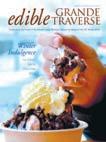
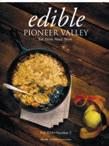
Sausages are made with natural casings, and offal from pork is used to prepare house versions of traditional European deli items like scrapple or braunschweiger.
You can also enjoy sandwiches and local craft beers on Heart & Trotter’s patio.
Look for the Heart & Trotters advanced recipe for a sous-vide chicken liver pâtê online at ediblesandiego.com.
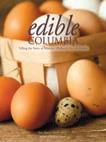
Explore a world of local food through the magazines and websites of Edible Communities. We’ll introduce you to the chefs, farmers, brewers, home cooks and others who inspire and sustain local flavors across the US and Canada.
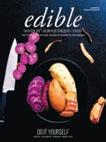

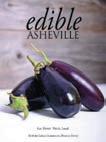

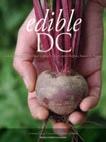
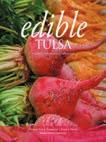
Learn more at ediblecommunities.com
